Exhibition place:Second Floor, Fashion Gallery
Exhibition time:2020.10 - 2021.10
Qipao is one of the most representative dresses of Chinese women. Women are dressing in Qipao all over the world in modern society. The Hangzhou Qipao Festival is working on introducing and using Qipao to connect the world since 2017. Since the first exhibition in 2018, China National Silk Museum keeps holding the series of the Global Qipao Invitational Exhibition every year.
The theme of the Qipao exhibition this year is “Poetry”. There are about 40 pieces of Qipaos designed by designers from all over the world. Designers have used their talent and imagination to present diverse elements of “Poetry” on their works. Following their fantastic works, we will listen Chinese poets singing the ancient grace song, hearing romantic story told by bards, watching fashion coming in and going out in a place . Like poetry is a world-used Genre, we hope the Qipao can spread far as a poetic unit, in a poetic way, with a poetic concept.
Unit 1 Grace of the Nine Regions
Ancient Poetry represents grace, elegance and gorgeous in Chinese people’s mind. They are all familiar to the ancient poetry. With thousand-years’ development, Chinese poetry have developed lots of forms and rhythms, but grace is the soul that always remaining inside. In this section, Qipao will be a new kind of form which shows the Chinese grace of the poetry.
1. Old Summer Palace – Xiong Ying
This dress has recorded the spectacular view of the “Old Summer Palace” in the past. It is like a journey going through the history of China. With the Chinese cultural mark on the dress, women will be able to show the beauty of oriental country.
Xiong Ying is a famous fashion designer who is known as the “Aesthetic Expert after Celebrities”, she established her brand “Heaven Gaia”. With the goal of making clothes simple, quality and beauty, her design style has always been fashion, grace and detailed.

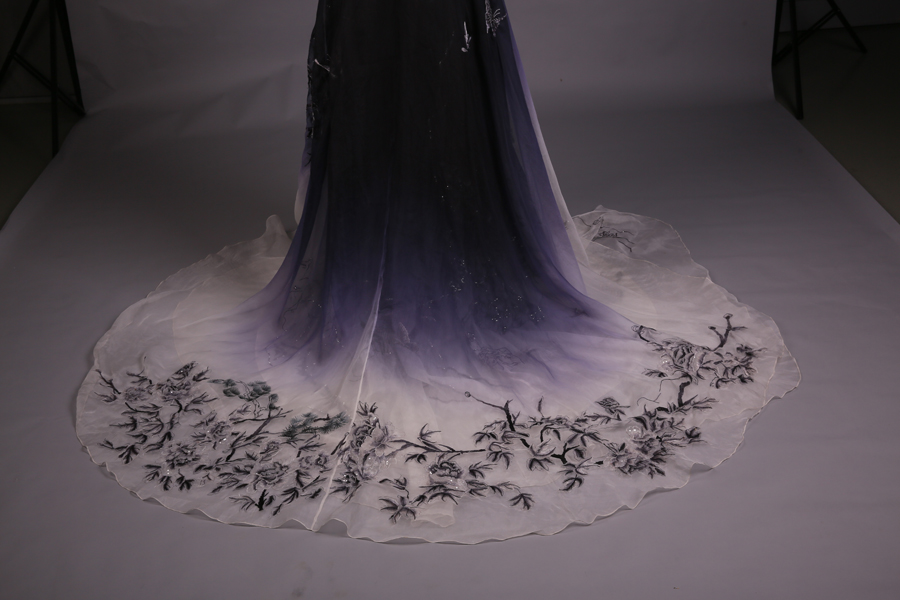
2. Blue and White Porcelain – You Jia
This Qipao is one of the Qipao wearing by the MISS MANNERS of Beijing 2008 Summer Olympics. The inspiration is from traditional Chinese blue and white porcelain. The dress is in Qipao shape on the top but also contains a fish tail skirt shape in the bottom. Blue and white are the colors stand for gentle and grace, with the Su Embroidery and crystal form the patterns, the whole dress is able to show how gorgeous the Miss Manner is.
You Jia is an associated Professor and Supervisor of the Master students in Beijing Institute of Fashion Technology (BIFT), she mainly teaches Clothing Design and Creative Design, etc.
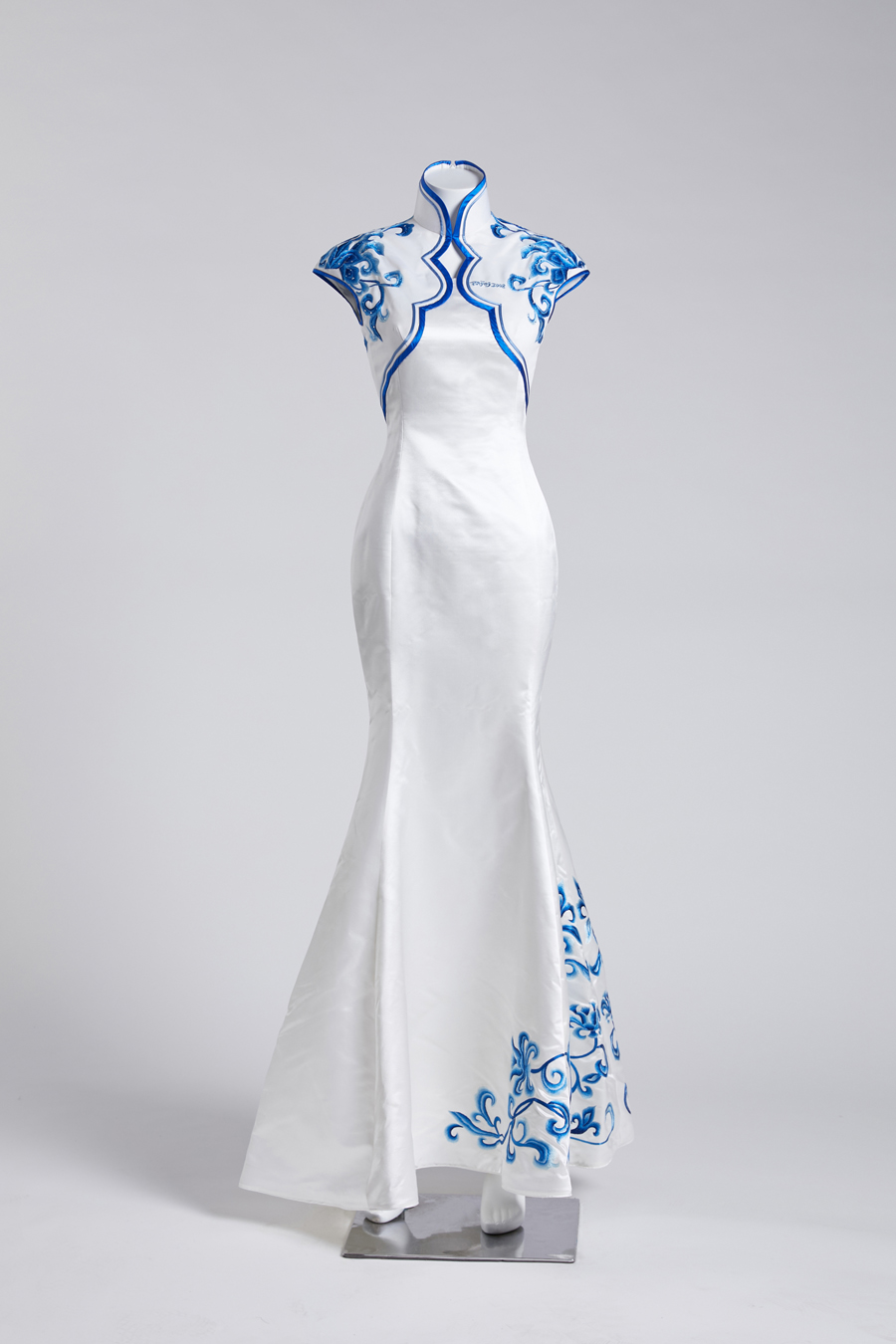
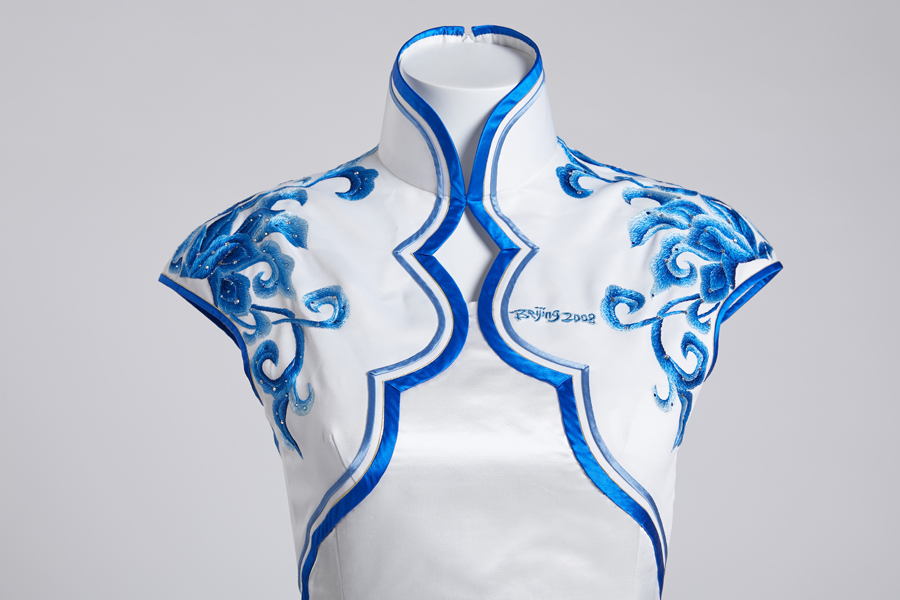
3. The Wax and Wane - Xu Nuo
The work is inspired by Su Shi's First Visit to the Red Cliff: “Water flows away but is never lost; the moon waxes and wanes, but neither increases nor diminished.” As a native of Nanjing, I grew up overlooking the city from the city wall, looking up at the branches and leaves stretching outwards under the thousand-year-old firs, and observing the cracked stone slabs at the Sun Yat-sen Mausoleum. I was shocked by these spectacular scenes and ancient atmosphere, which gave me a deep impression of the transition between ancient and modern times. The body may be dead, but the spirit remains forever.
Technically I opted for devore combined with bead embroidery. The contrast between the burnt silk and the luxurious velvet and beads is a way of expressing the waxing and waning of the new and the old.
Xu Nuo, born in 2000 in Nanjing, Jiangsu Province, currently studying fashion in Studio Gottelier, Shanghai Institute of Visual Arts. As a 3rd year student, she has worked as a shooting assistant at The Ballroom for three times and as an event assistant at Shanghai Fashion Week for several times. She likes to experiment with the techniques of embroidery, devore as well as heat pressing and design with semi-transparent materials. The themes of her designs tend to be inspired by intuitive feelings or thoughts on phenomena.
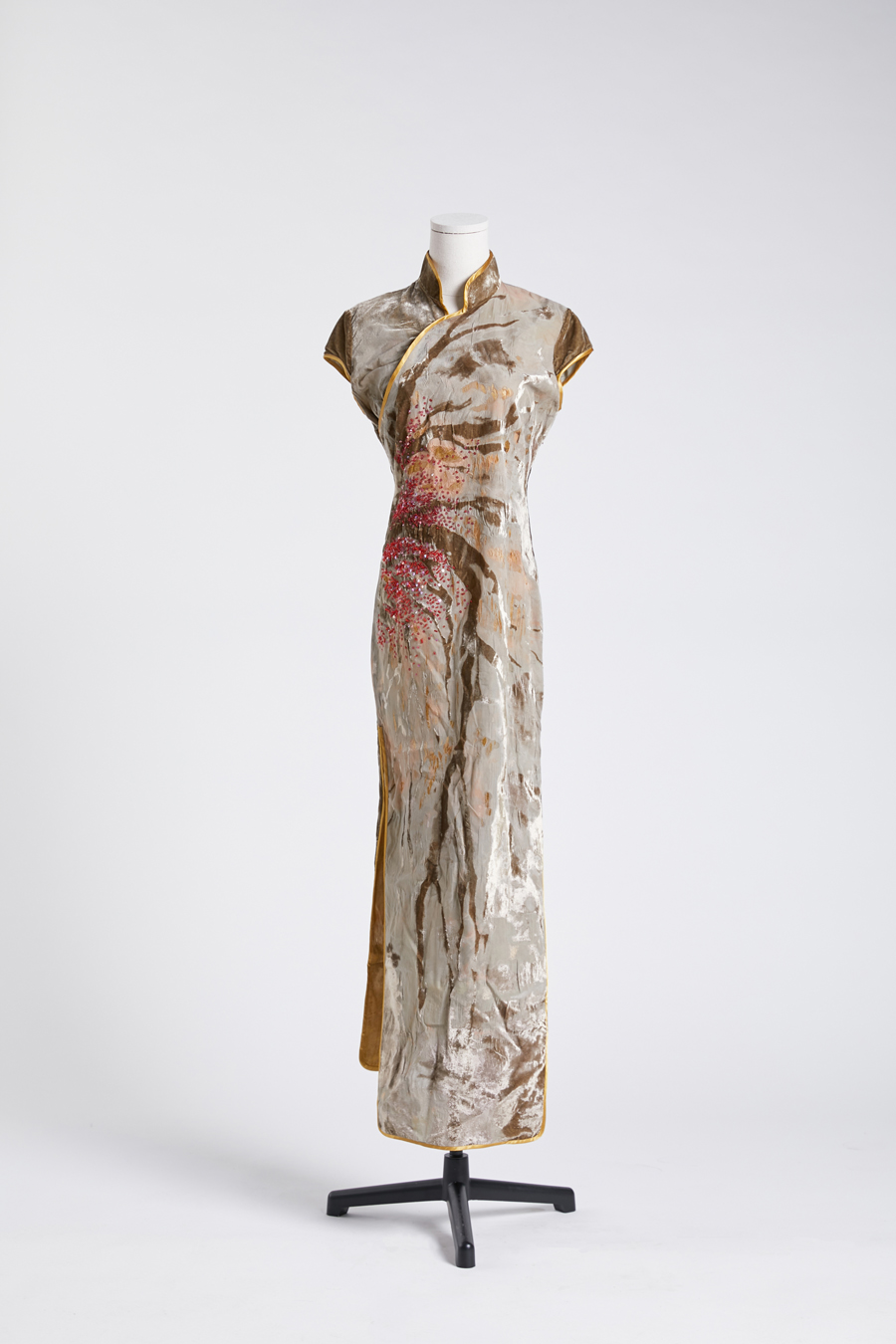
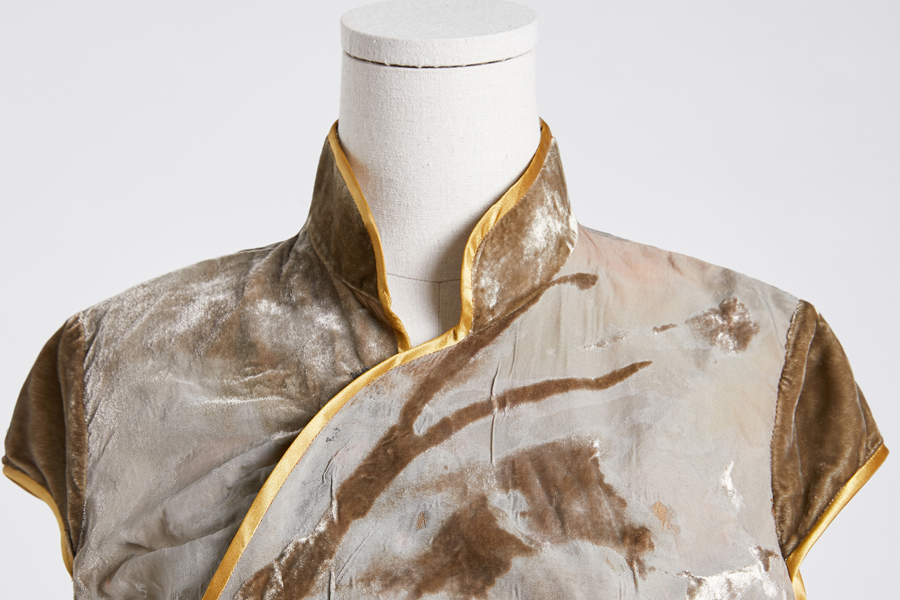
4. Plum Blossoms – Shih Shan-Ying
This Qipao is inspired by a poem namely ‘Plum Blossoms’, written by Anshi Wang in Song dynasty.
The entire design represents those who are fearless and persevering in a difficult time by using symbols of abstract geometric shapes and concrete plum blossoms. I use lines arranged in crisscross patterns to create shadow and light diversity, as well as a plum blossom with rough snow texture. These symbolize a hard situation and a man having sharp sense of integrity respectively. This design combination can echo and translate the core of the poem.
Shih, Shan-Ying has awarded a PhD of Building in the University of Newcastle (Australia), and currently working in the department of textile and clothing at the Catholic Fujen University. Shih’s research interest is in computer aided design, immersive virtual environment and 3D print aided clothing design.
Several plum branches stand at the wall corner there;
Even in extreme cold they, alone, flower in delight.
From a distance I know that they are not snow white,
For sweet scent floats and lingers in the freezing air.
——Wang Anshi

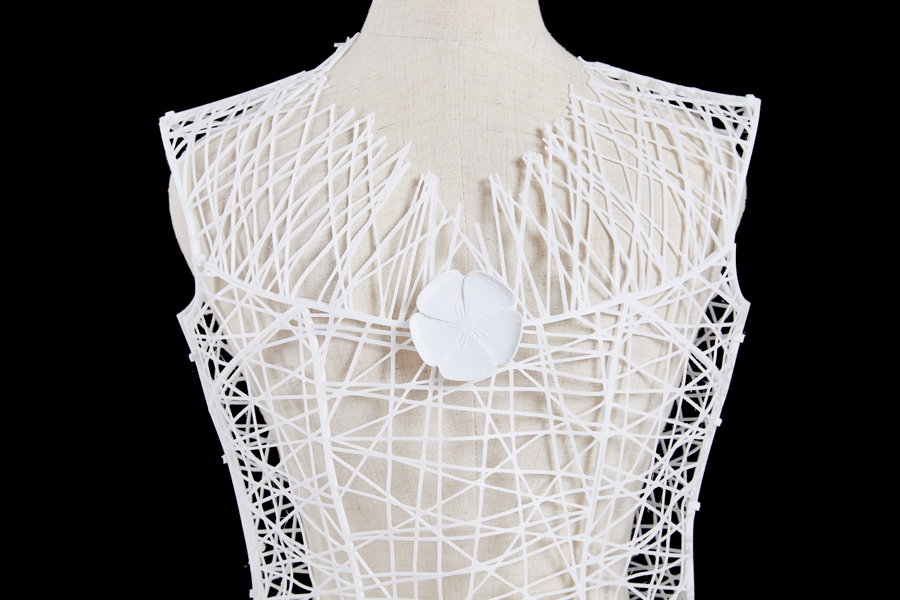
5. Magnolia – Lin Xia
The Magonlia stands for noble, grace, patriotic and loyalty in Chinese culture, people regarded the Magnolia as the “Gentleman of All Flowers”. The Designer has used her technique to perfectly combine the Magnolia and the Qipao, showing the lovely leaves and the inviting beauty of the flower.
Lin Xia, A master of Chinese arts and crafts. The master of Chinese embroidery art, a senior artist of Arts and Crafts, Director of Tai Embroidery Art Museum, Vice Director of Tai Embroidery Research Institute, and Zhejiang Tai embroidery apparel Limited company chairman and art design director, the third generation inheritor of “Taizhou embroidery”

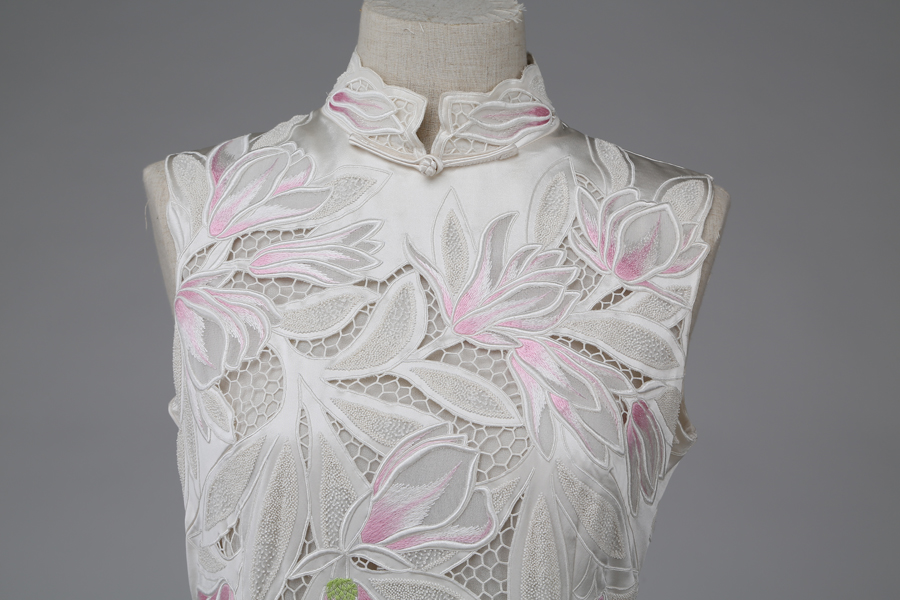
6. Spring Dawn – Susana Arce Dubois
A fusion between Chinese and Spanish culture and fashion. This piece is a fusion between the flamenco dress (traditional costume and symbol of Andalusian culture and fashion from the South of Spain) and the Qipao, the iconic traditional Chinese dress. The skirt is made up of 12 ruffles, typical of the flamenco dress -of different sizes, so that it does not have too much volume- that start at the waist and go all the way down to the feet. The bodice is figure-hugging, in the style and with the high collar of the Qipao.
I will create the fabric by hand-dyeing and silk chiffon fabric golden yellow - a traditional Imperial Chinese colour- and then “felting” it with merino wool, bamboo fibres, mulberry silk fibres and sari silk fibres. The different colours of the soft merino wool and fibres remind us of springtime: yellows and greens, with small touches in red, pink, blue and orange. The combination of these wool fibres with the bamboo fibres and the mulberry and sari silk fibres - will give the fabric a special luminosity - creating the illusion of a field of flowers, on which the sun rays reflect after a storm. The many ruffles of the skirt create movement in the dress, reminding us of the spring wind blowing on the leaves and flowers.
Susana Arce Dubois
I have always been an artist by vocation. From an early age I felt a great attraction for textiles, as I learnt to saw, knit, and crochet from my grandmother. I believe that working with textiles has always helped me retain my own identity. My trajectory as a designer, textile artist and craftsmaker is long and varied.
How suddenly the morning comes in Spring
On every side you hear the sweet birds sing
Last night amidst the storm - Ah, who can tell
With wind and rain, how many blossoms fell?
——Meng Haoran
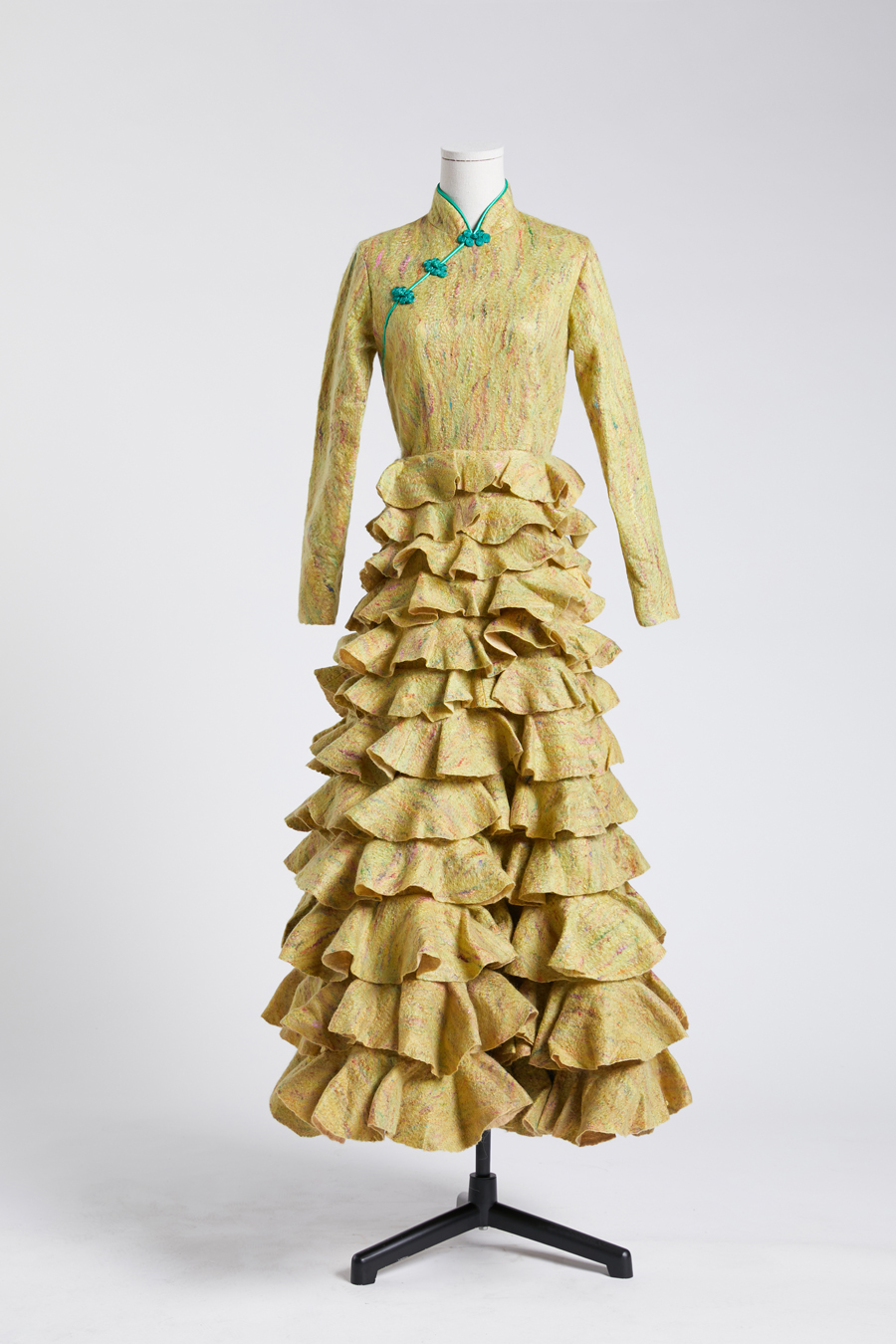
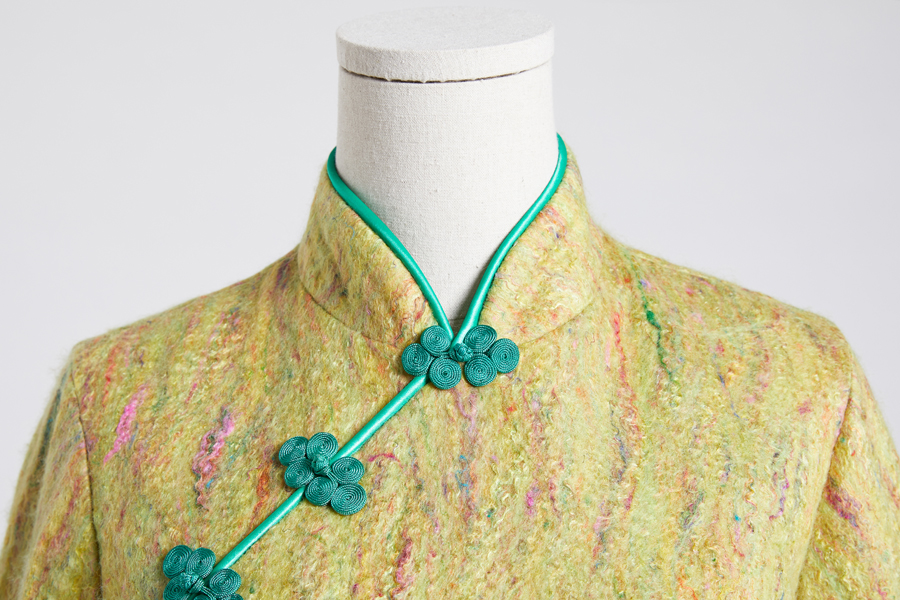
7. Night of Jingjiang - Jiang Pei
The design of the Qipao is inspired by the poem Chengdu Song written by Zhang Ji in the Tang Dynasty. The poem describes the scenery in the suburbs of Chengdu. In the distance, there are rolling green hills, while nearby, there are restaurants everywhere, all prosperous. On the Qipao, the mountains in the distance and the prosperity in the near distance merge into one, expressing the harmonious coexistence between man and nature. The technique of beading and laser cutting were applied.
Jiang Pei, born in Shanxi, China, a current 3rd year student studying fashion design in Studio Gottelier, Shanghai Institute of visual arts. During the 1st year of the college, she did an internship at SIRLON and worked as a backstage assistant during Shanghai Fashion Week. The menswear she designed in the 2nd year was exhibited in the Balancing shop in Shanghai.
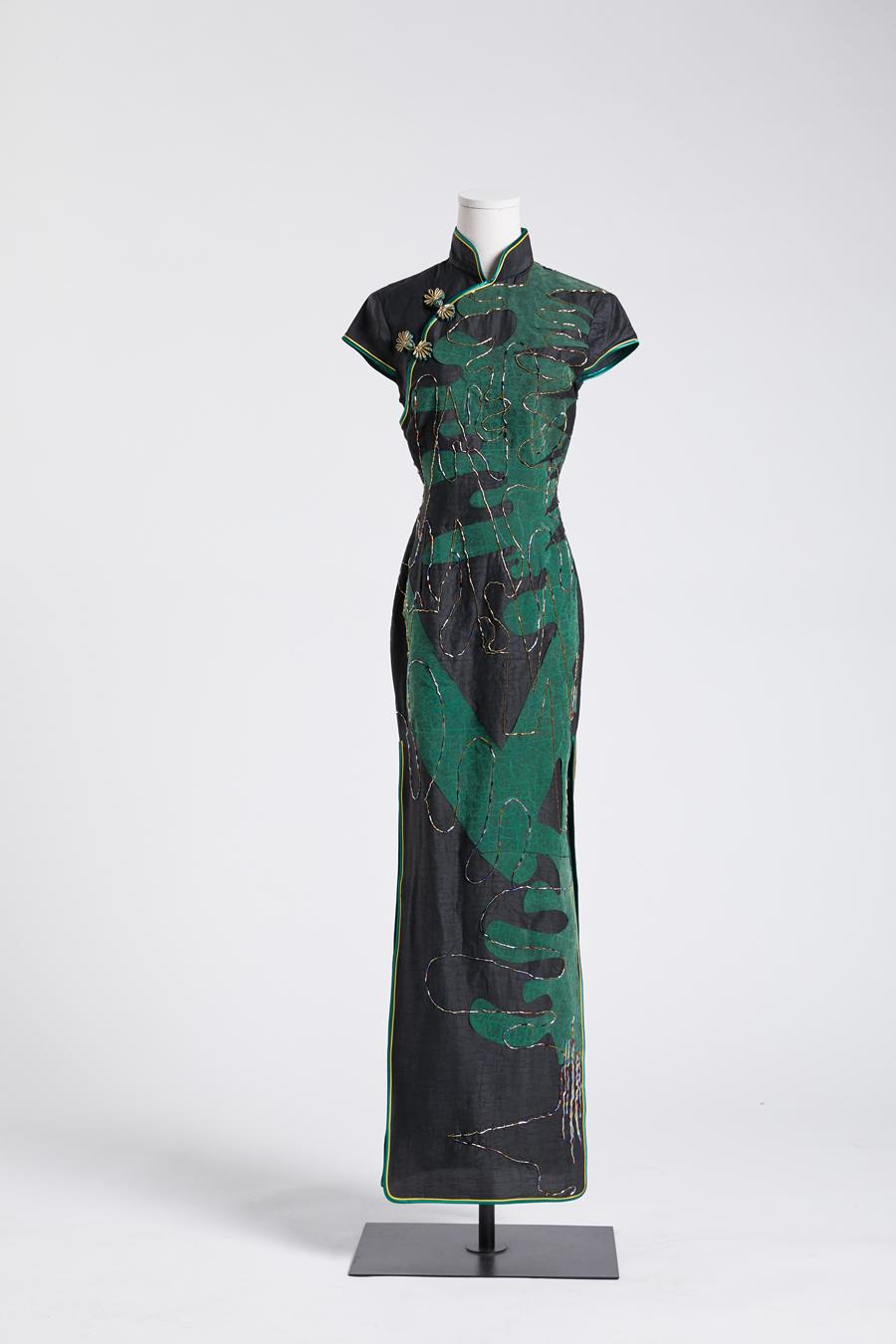
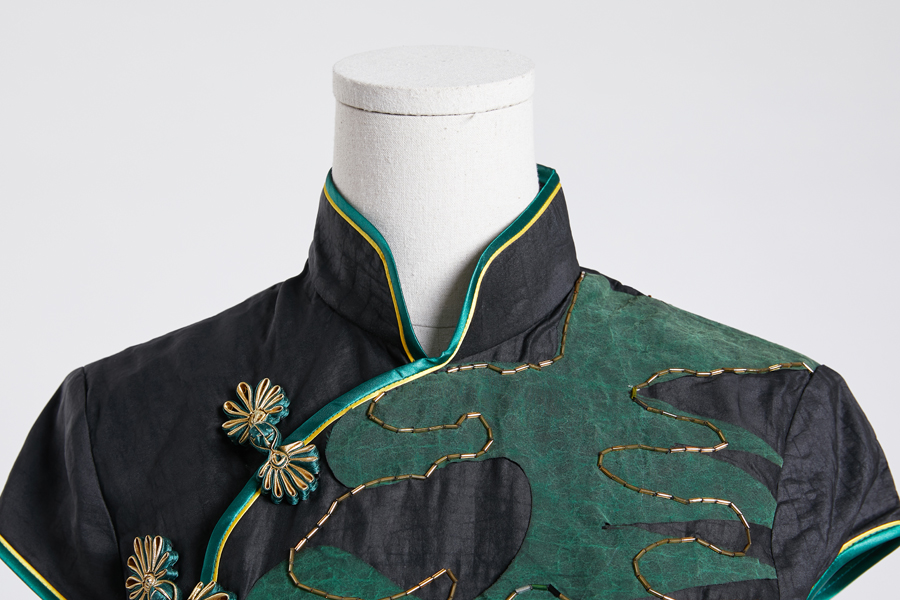
8. Lushan Waterfall - Liu Zixuan
The inspiration of this Qipao is from Li Bai’s poem “Lu Shan Waterfall”, the poem which describes describe how astonishing the waterfall is. The main goal of this dress is to make audience feel the exact feeling as they watch the waterfall when they see this Qipao.
This Qipao uses white color as the main color, and on the Qipao’s traditional structure, there are some black on it. It also has lots of yarn layers, which refer to the water mist around the waterfall, those yarn layers can also creating the mood like the Chinese traditional painting for the whole dress.
Zixuan Liu is an MA costume design for performance student at London College of Fashion of the University of the Arts London. She received a bachelor’s degree at Jiangnan University, China. And she studied as an exchange student at In ha University, South Korea. She is an art director and costume designer of theater and movies, has accumulated rich experience of art and costume design in international art festivals, theater festivals and various performances.

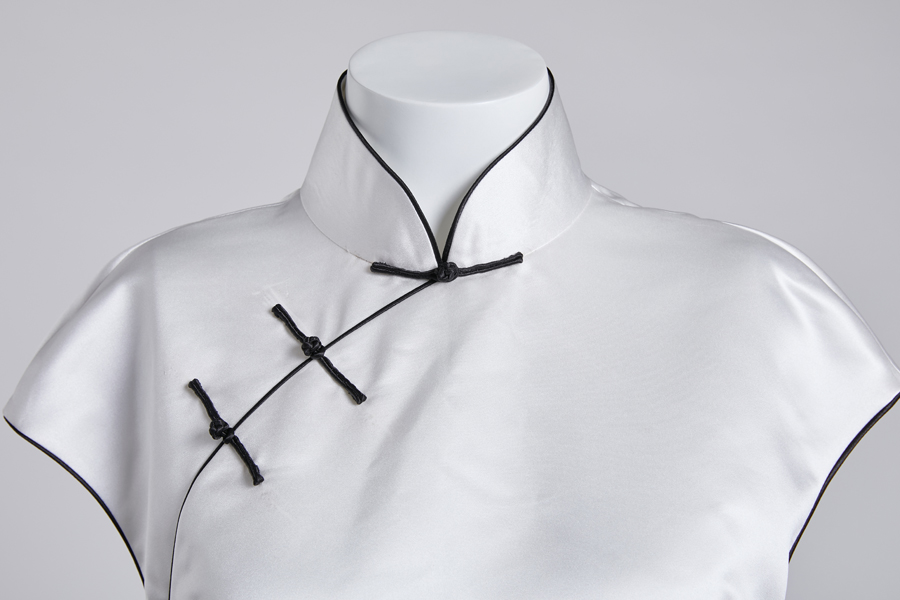
9. Wishes under the Moon – Chang Tsui-yuan
This work is inspired by the Song dynasty poet Su Shi’s poem Shuidiao Getou. The designer used a khaki modified knitted Qipao to present a natural, comfortable, and down-to-earth life. The claret-red, ankle-length pleated drape on the khaki Qipao, akin to the curtains of the palace in the sky has the functions of improving the appearance of one’s body shape in addition to its beauty and elegance.
The black nylon mesh cloak with red edge line represents the gorgeous jade and crystal mansions and the airy design the unlimitedness of one s dreams. In addition, the circular fan and impressionistic traditional Chinese painting with a sense of loneliness represent the deepest yearning for one s family during the Mid Autumn Festival. The gorgeous red Qipao collar embellishment expresses Su Shi’s aspiration for “May we all be blessed with longevity. Though thousands of miles apart, we are still able to share the beauty of the moon together”.
Chang Tsui-yuan, The Associate Professor of the Fu Jen Catholic University. She has received lots of awards all around the world, includes: 2018 International Fashion Art Biennale in Seoul with KIA, 2016 The 28th International Costume Congress , 2012 The 27th International Costume Congress, 2011 The 25th International Costume Congress, etc.

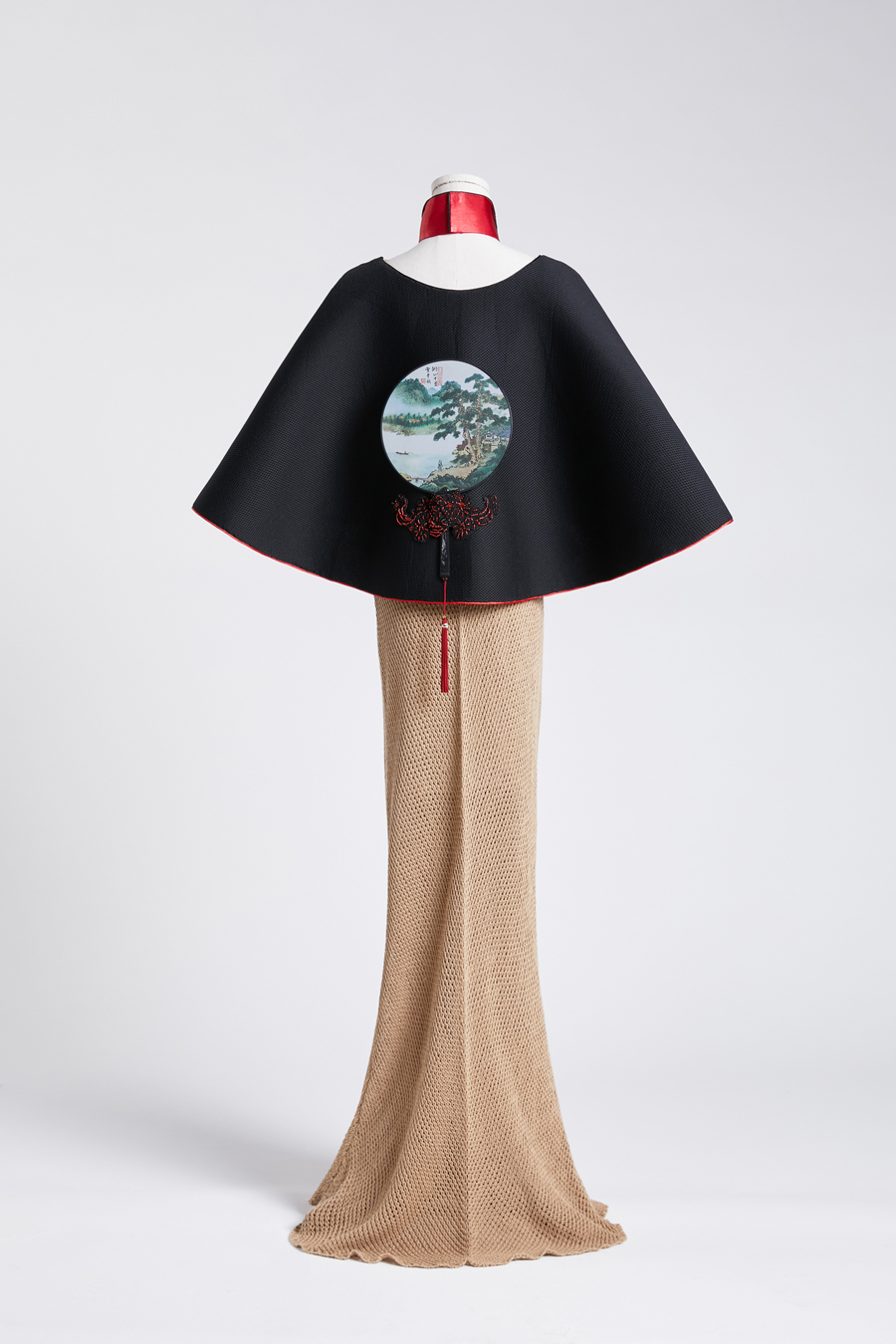
10. Plum Blossom – Yu Hua
The inspiration of the design is from a doctor whose name is Zhu Haixiu. She just graduated from her college, but she already went to the most dangerous place of Covid-19 in China, with no fear. I have seen a picture of her, seeing her full of tiring on her face, I was very moved.
Plum Blossom is the flower represents Wuhan, and also represent with brave and no fear. I want to use Plum Blossom to wish the people all over the world to get over the Covid-19 as soon as possible.
Yu Hua, Loves design and arts. Graduated from Hong Kong polytechnic university with a master's degree in design and a bachelor's degree in fashion design. In 2011, she was selected as one of ten outstanding young people in Hong Kong.
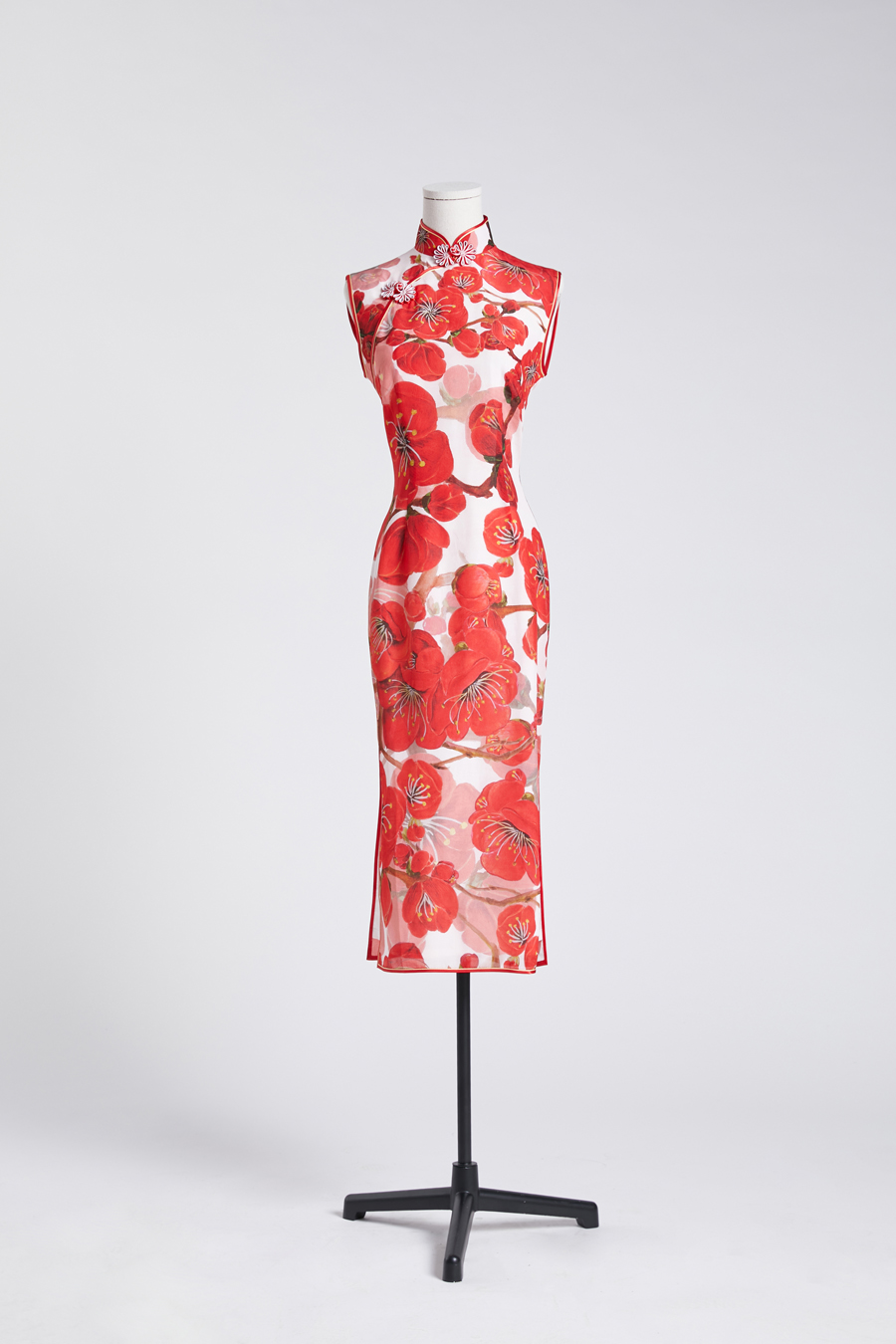

11. Sending – Liu Xiaotong
The inspiration of this work Send comes from poem Written on a Rainy Night to My Wife in the North.The embroidery on the right shoulder is an abstract pattern of archaic windows, embellished with Miao craftsmanship - tin embroidery. The main body of the Qipao is tie-bleached to play up the mood of misty rain in the poem. By the window, there is the poet stroking the faded family letters. The yearning for home has been silently growing like the trimmed candle wicks and it is everywhere on the scroll. The meandering embroidery thread in the middle of the Qipao represents this strand of yearning connecting two ends.
The poem was written when the poet Li Shangyin was in a foreign land, where distance was an insurmountable gulf, and the return date was uncertain.
Nowadays, transportation is convenient, but the epidemic has brought people back to the days when it was difficult to see each other, and I hope that this Qipao can help to send a message of longing for people separated from each other at this special time.
Elena Liu, born in 2000 in Liaoning, China,a current 3rd year student studying fashion design in Studio Gottelier, Shanghai Institute of Visual Arts, She takes an active part in competitions and that includes FashioNXT in Oregon, USA and the Sports and Performance Wool Challenge, etc. Also, she has ever worked as a backstage assistant for SIRLION during Shanghai Fashion Week. As a big fan of minority culture, she is deeply attracted by Su embroidery, Miao embroidery, tie-dye, batik and other ethnic handicrafts.

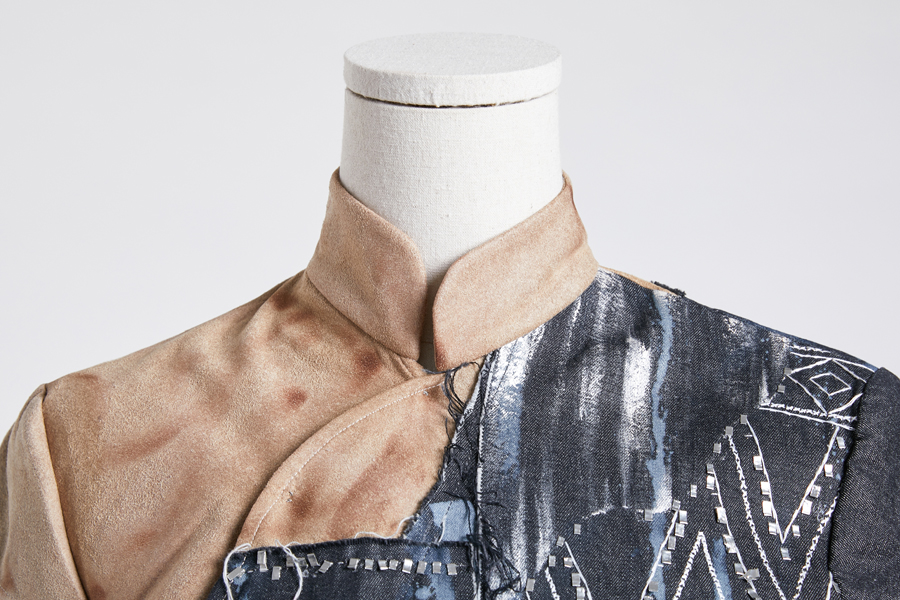
12. Dawn Blossoms Plucked at Duck – Li Yingjun
The design focused on the. Reconsider the Chinese Clothing culture in a poetic way. In the main time, the Qipao explores the traditional “Crossing” structure, and tries to see if it is possible to “revive” it in modern fashion, and if it is able to bring the Chinese culture to the world.
Li Yingjun, Doctor of Fine Art, the associate professor of the Academy of Arts & Design , Tsinghua University. He have created his fashion brand called “jiu”. He focused on his research of the national culture and the fashion, and has published ten more paper and articles in this researching area.
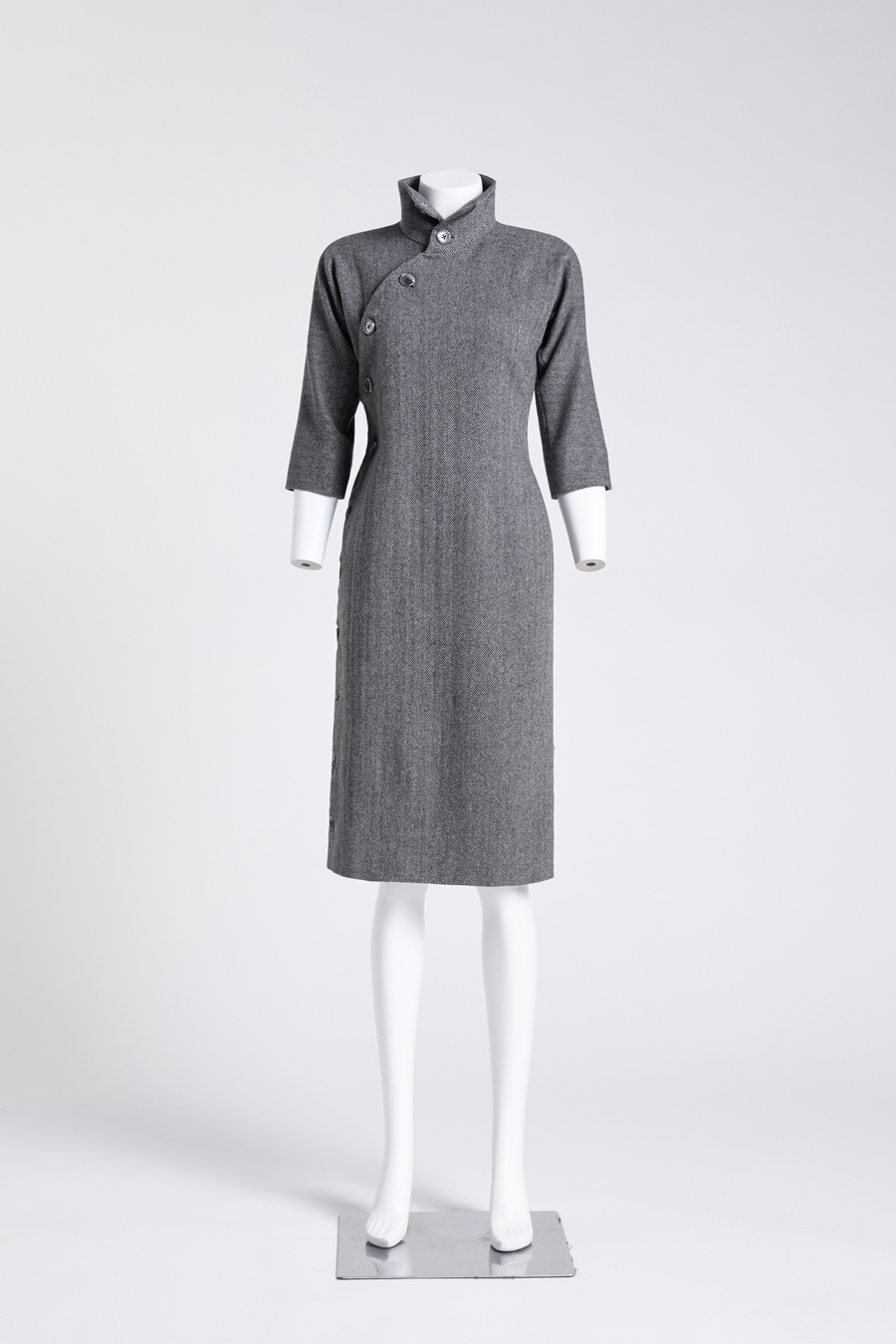
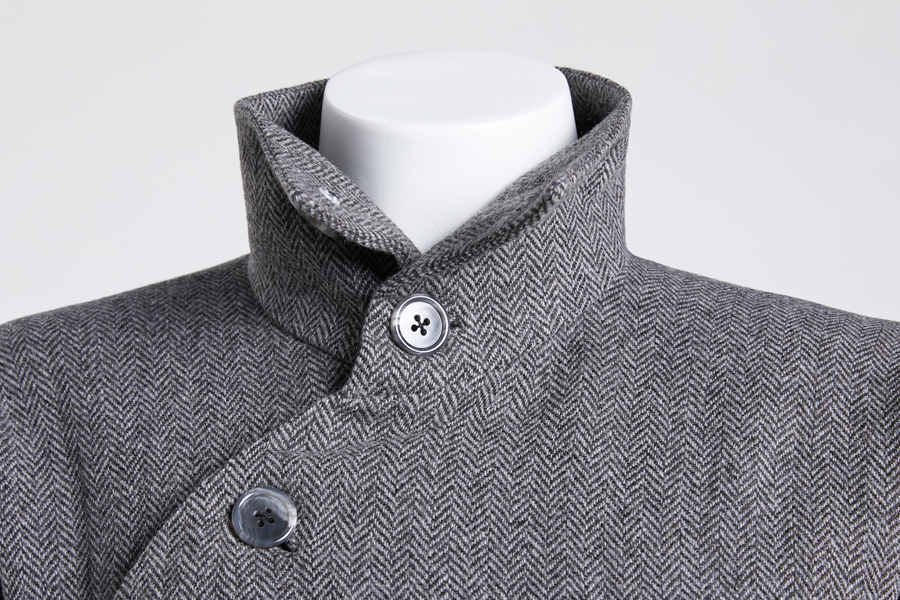
13. Homeland of Xiangyun - Jin Hui
The two dress choose Xiangyun yarn, a kind of the national intangible cultural heritage as the material of the design. The unique production process of Xiangyun yarn - plant printing and dyeing, 16 times of sunshine and river mud infiltration as the design inspiration. It embodies the Oriental aesthetic concept of the unity of heaven and man, the Renaissance of all things, and the integration of man and nature. In the design, it adheres to the spirit of "craftsman", combines traditional handicraft with natural materials, and uses the original The technique of "state" expresses the contemporary fashion modeling and reshapes the Oriental lifestyle of returning to nature and original heart.
Jin Hui is the designer graduated from Fine Arts Academy of Hunan Normal University, and also is the Top Ten Fashion Designer of China. She is the vice president and professor of the Fine Art Academy of South China Agricultural University.

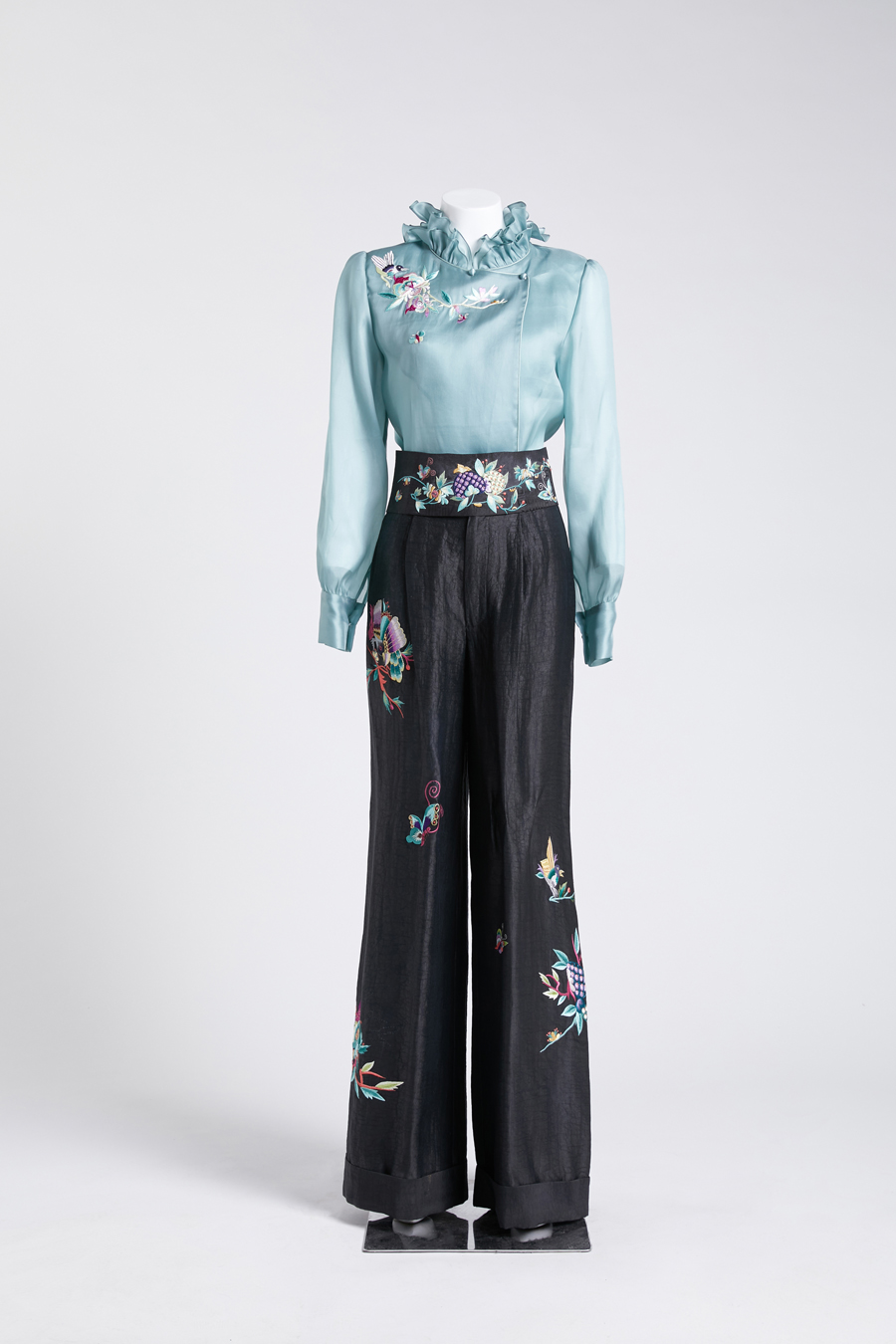
14. Melt – Jiang Ping
This dress aims to mix the traditional Xiangyun yarn, Yue embroidery and modern appreciation of beauty together in one, just like a melting pot. The main goal of the dress is to create a new series which can not only inherit the pass, but also can pass it to nowadays. The Qipao uses colors in the low saturation, and choose a simple but large clothes structure, to present the grace and harmony of the combination of China and the world.
Jiang Ping,Top Ten Fashion Designer in Guangdong Province, Vice President of International Fashion Trends Alliance, and Moderator of Guangzhou Education Experts Studio. Jiangping Studio has been committed to the fusion of traditional Chinese art and international fashion trends, with Guangdong embroidery and Xiangyun yarn(gambiered Guangdong gauze) as a key project of the studio. Ms. Jiang adheres to the spirit of artisans and keeps her creativity first, and promotes the national sentiment of “Chinese design” through “promoting intangible cultural heritage”.
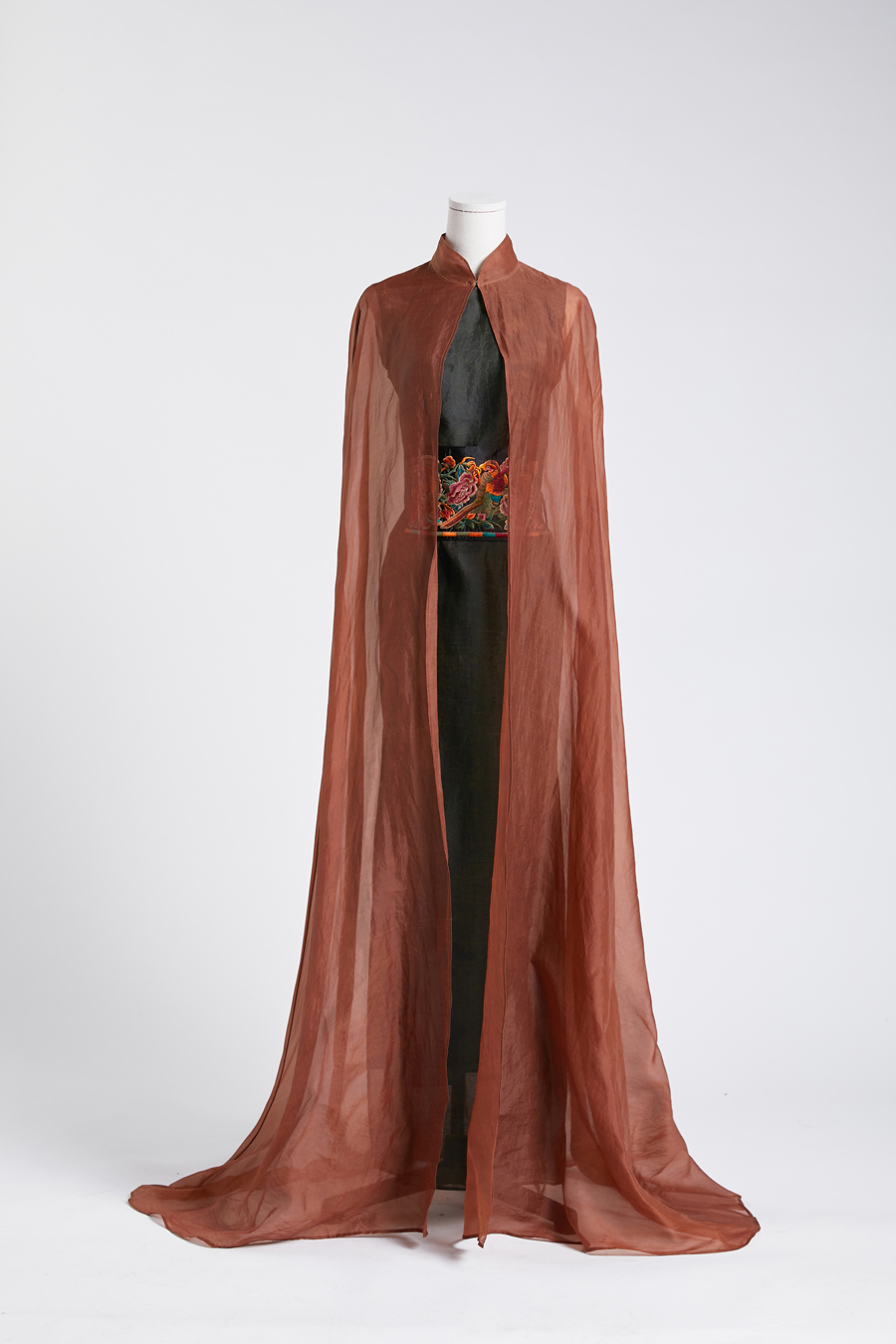
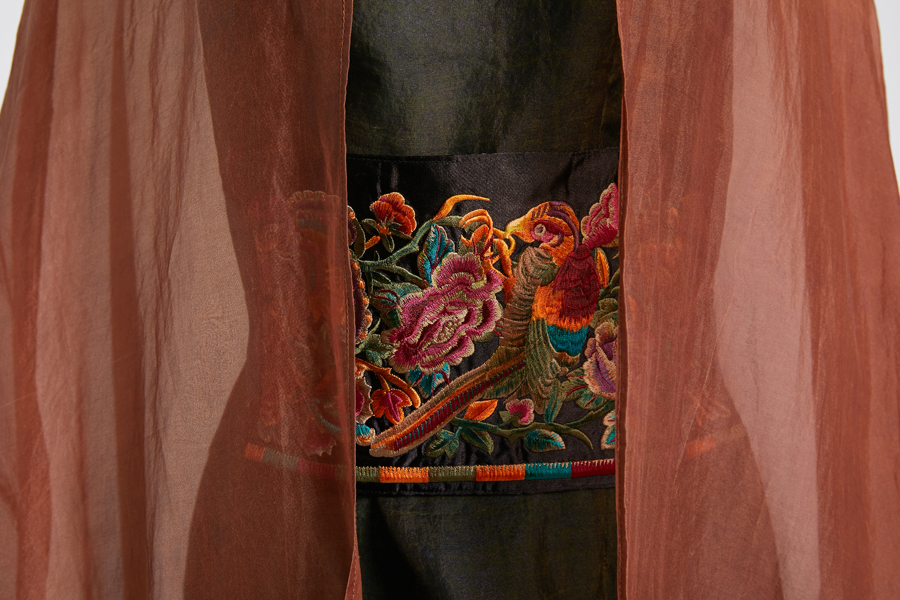
Unit 2 Romance of the Seven Seas
Poetry is a genre the whole world uses, although there are differences of forms and rhythms between cultures. Through the world poetry, we can always find “Romance” as a eternal theme. Romantic thoughts are varies, within poets’ inspiration, also within designers’ fascinating imagination in the Qipaos they created.
15. Kołbiela – Dorota Kołodyńska
In my project of Qipao I intend to use the Polish cutouts from the Kołbiela region as a main theme. I think that this kind of cutouts is a particularly expressive record of artistic content, like a poetic miniatures. What makes them characteristic is their variety and precision of designs, which arranges plant and animal motifs in symmetrical and geometrical square or circle forms in a clear and concise way. Polish folk handicraft ornaments adorning my Qipao blend in a surprising way with the symbolism and splendor of gold, which is an important element of great silk weaving tradition in China.
My project will be based on the classic Qipao form with a characteristic stand-up collar and diagonal fastening. However, I want my dress to get a slightly theatrical form, so I will emphasize women femininity, by accentuating the waist and slightly highlighting hipline. Shining of the bright gold will be subdued by the delicate accents of pale blue, which in the Chinese tradition is the color of spring and harmony.
Dorota Kołodyńska, Theater and Costume designer, graduated from Academy of Fine Arts in Warsaw, major in graphic arts and theater design. She currently works as a teaching assistant in the Stage design Department of Academy of Fine Arts in Warsaw, lecturing on costume design.She has lots of experience on numerous theater in Poland.

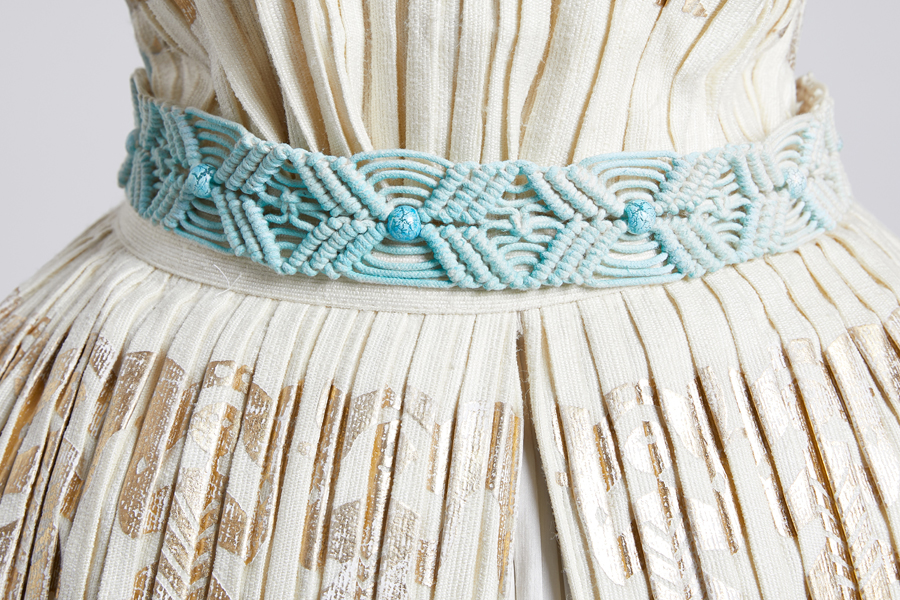
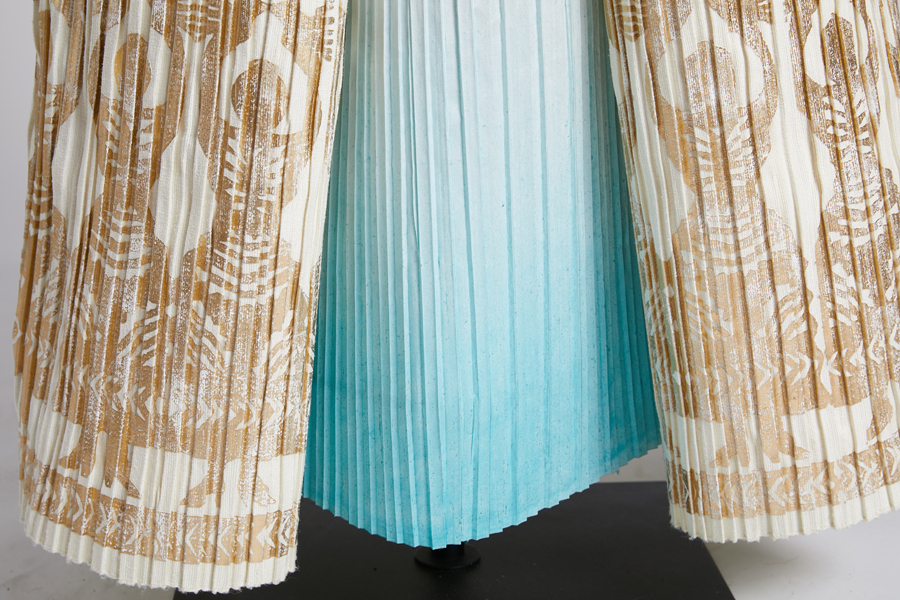
16. The Lovely Flowers – Kima Guitart
This Qipao is inspired by two gardens and a poem.
One is the garden of my childhood where my mother and my grandmother used to grow plants with colorful flowers and fantastic scents. As a child I spent there many hours, on my own, dreaming. The second is the garden of my home in Barcelona, where I live with my husband and our daughter.
The poem is by Emily Dickinson (1830-1886). In between the brushstrokes I wrote the poem in calligraphy. My Qipao “Lovely Flowers” is painted with a direct technique, using anilines on natural silk shantung and anti-spread for the brushstrokes to have clear contours.
Kima Guitart
I held solo fashion shows in art galleries, museums, a Buddhist temple, along with outdoor shows all over the world. I chose silk as a pictorial medium. I use traditional Oriental techniques, but always with a personal voice of experimentation engaging with the enormous opportunities silk offers. Maybe silk itself, the perfect symbol of metamorphosis, pushed me through this ceaseless evolution, to continuously having fun, learning and creating. I feel I am the heir of those who worked before me to assimilate the concept of beauty into daily life. I still believe that working with silk is an enriching process.
The lovely flowers embarrass me,
They make me regret I am not a Bee
——Emily Dickinson (1830-1886)
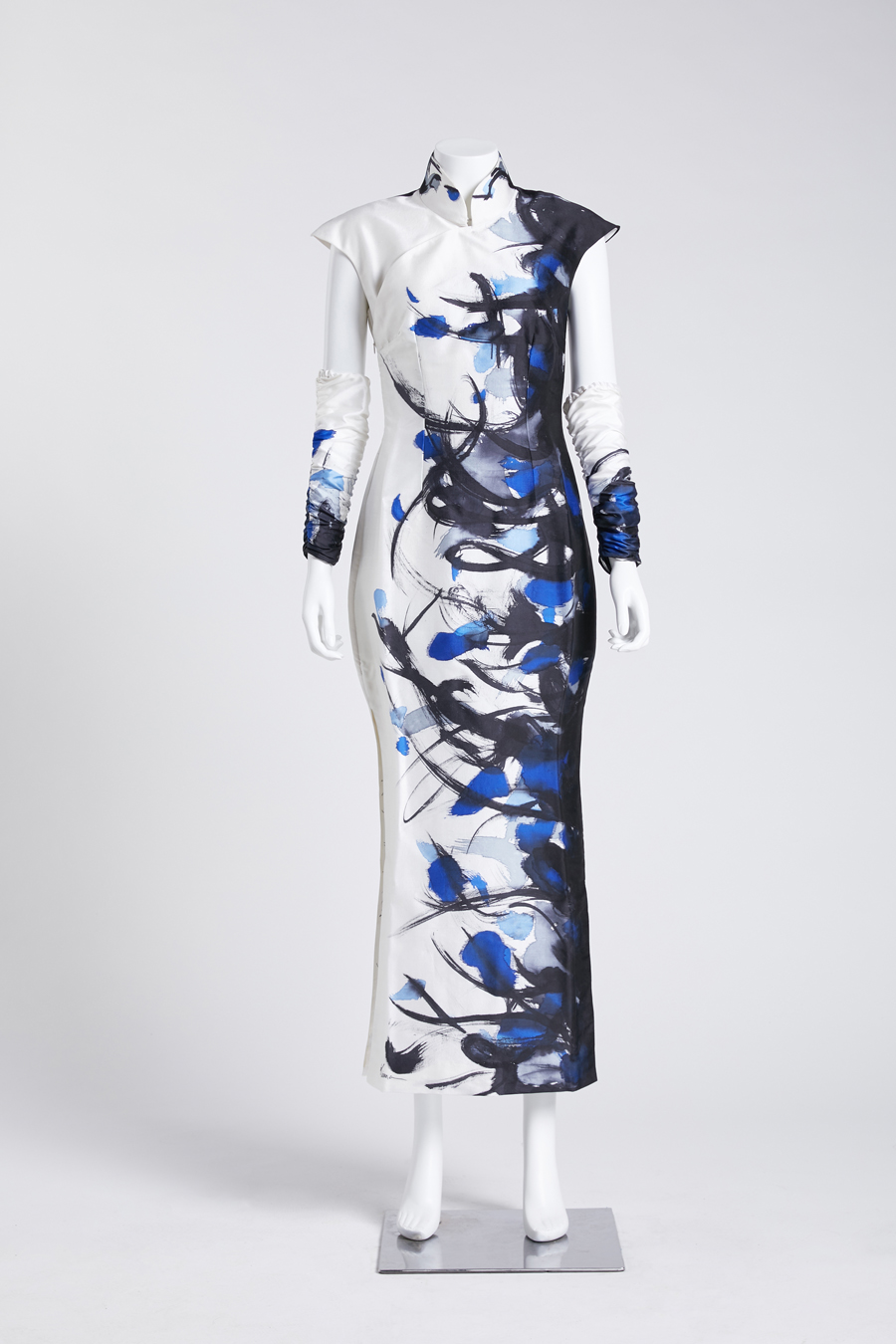
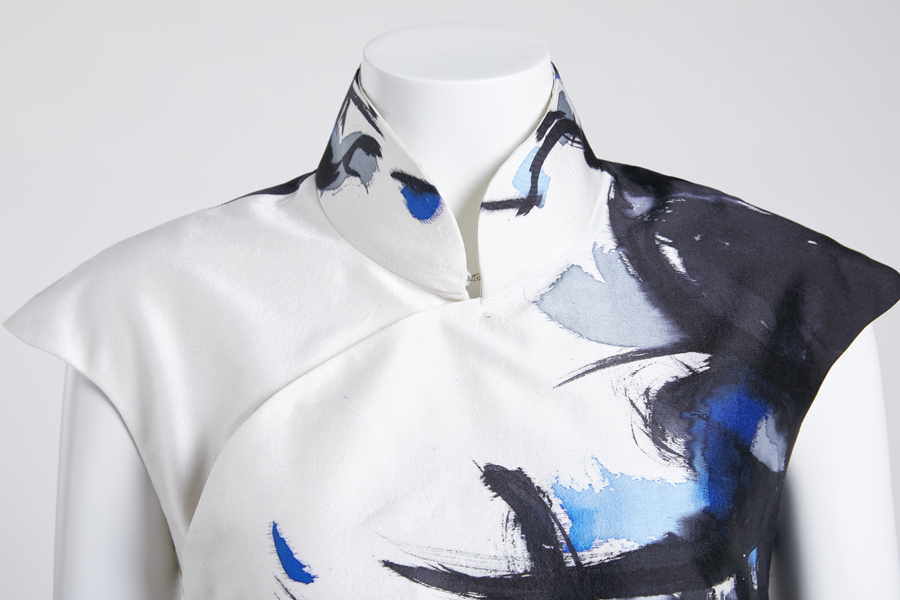
17. Hills and Rivers – Kima Guitart
My Qipao “Hills and Rivers” is inspired by this poem by Emily Dickinson (1830-1886).
This Qipao is painted on natural silk shantung and organza with a direct technique, anilines, bleaching and gold foil.I superposed a layer of organza on the shantung in order to veil and reveal the underlying paint. It is to add mystery and symbolic value, for in my country’s tradition organza is the fabric used in all rites of passage of the lives of women.
Kima Guitart
I held solo fashion shows in art galleries, museums, a Buddhist temple, along with outdoor shows all over the world. I chose silk as a pictorial medium. I use traditional Oriental techniques, but always with a personal voice of experimentation engaging with the enormous opportunities silk offers. Maybe silk itself, the perfect symbol of metamorphosis, pushed me through this ceaseless evolution, to continuously having fun, learning and creating. I feel I am the heir of those who worked before me to assimilate the concept of beauty into daily life. I still believe that working with silk is an enriching process.
The Hills erect their Purple Heads
The Rivers lean to see
Yet man has not of all the Throng
A Curiosity
——Emily Dickinson (1830-1886)
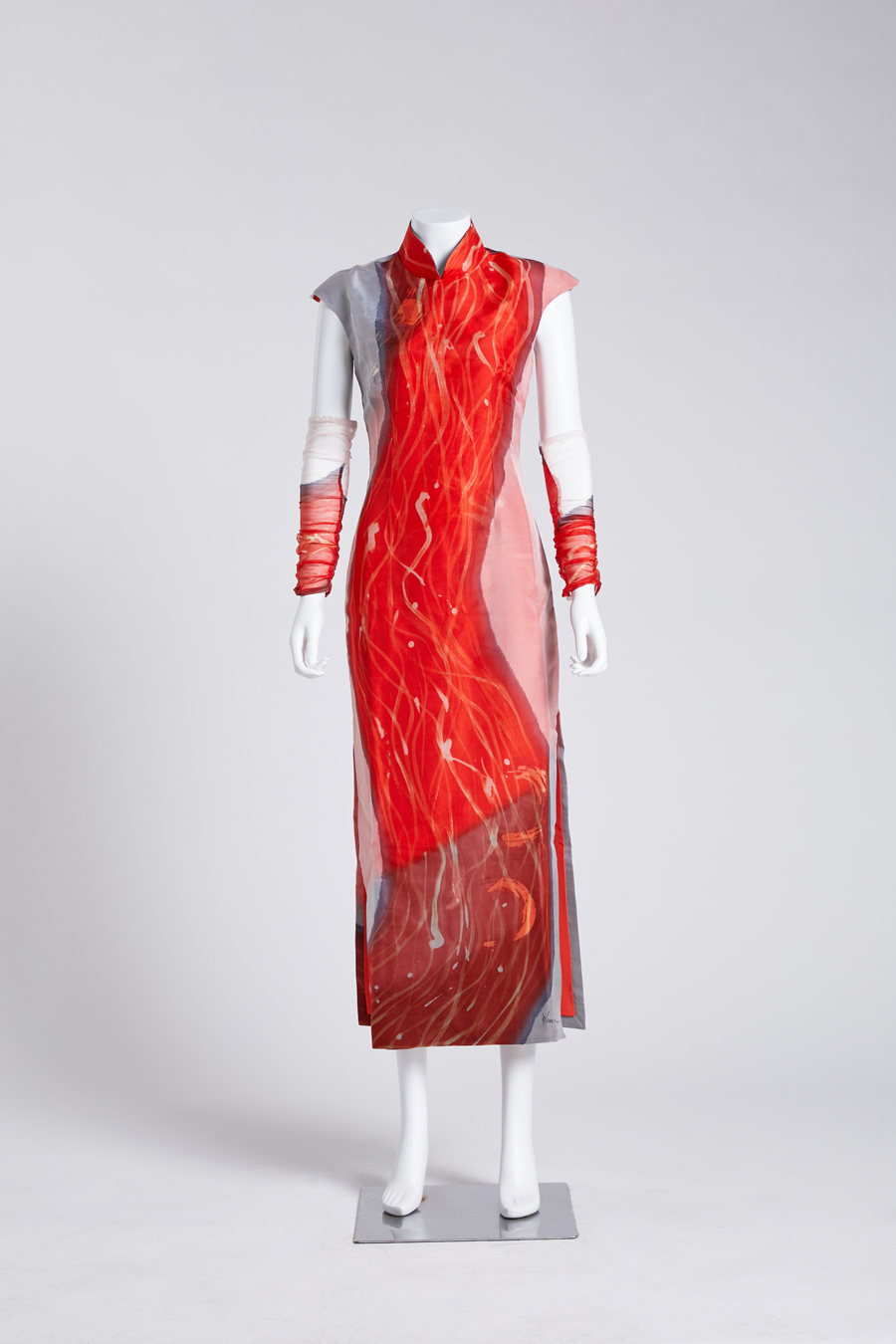
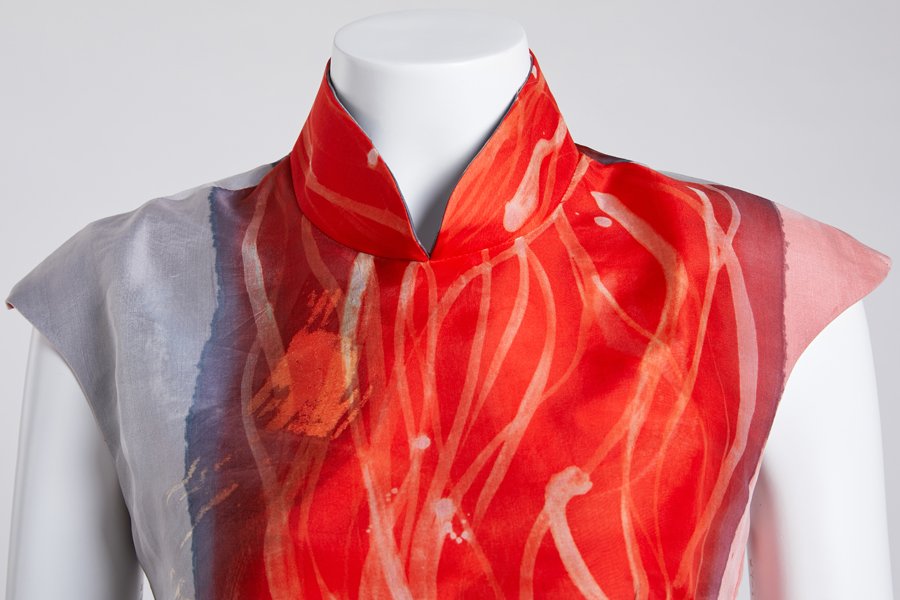
18. Tree Dress – Maria Carmen Perez Pastor
The first proposal is made with silk organza and cactus fabric with the pojági sewing technique. The drawing is an almond tree and the flowers are superimposed made of silk painted by hand and with volume made with the hot balls.
I am a craftswoman, fashion designer and textile creator. I've been in the profession for 30 years. I studied couture patterns, design and clothing. I also trained in the different silk painting techniques, in the manipulation of wool to make nuno-silk, in the dyeing with natural dyes, in headgear and feathers, all related to fashion. I have designed and created collections to present them on different catwalks where all these techniques come together.
The Hills erect their Purple Heads
The Rivers lean to see
Yet man has not of all the Throng
A Curiosity
——Emily Dickinson (1830-1886)


19. Fish Dress - Maria Carmen Perez Pastor
The second proposal is made of denim fabric based on pieces sewn together with the patchwork technique. On the back she wears ruffles emulating the sea made of wool and silk with the nuno-silk technique. There are also some fish made of silk that seem to be jumping on the waves thanks to a wiring system. There is also a fish closing the dress at the button height.
My name is Maria Carmen Pérez Pastor, from Spain, and my brand name is “CARMEN PASTOR”.
I am a craftswoman, fashion designer and textile creator. I've been in the profession for 30 years. I studied couture patterns, design and clothing. I also trained in the different silk painting techniques, in the manipulation of wool to make nuno-silk, in the dyeing with natural dyes, in headgear and feathers, all related to fashion. I have designed and created collections to present them on different catwalks where all these techniques come together.
The Hills erect their Purple Heads
The Rivers lean to see
Yet man has not of all the Throng
A Curiosity
——Emily Dickinson (1830-1886)
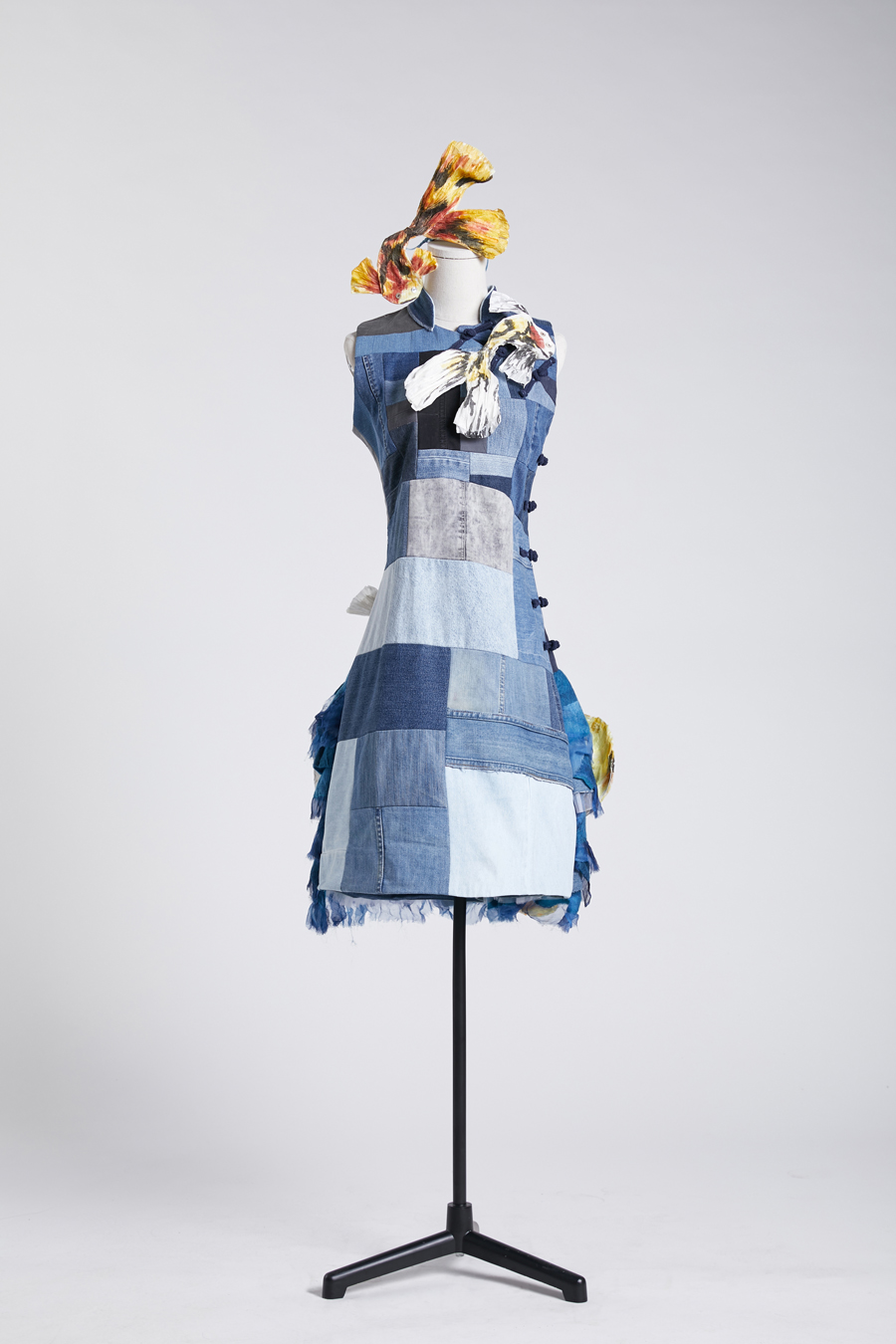
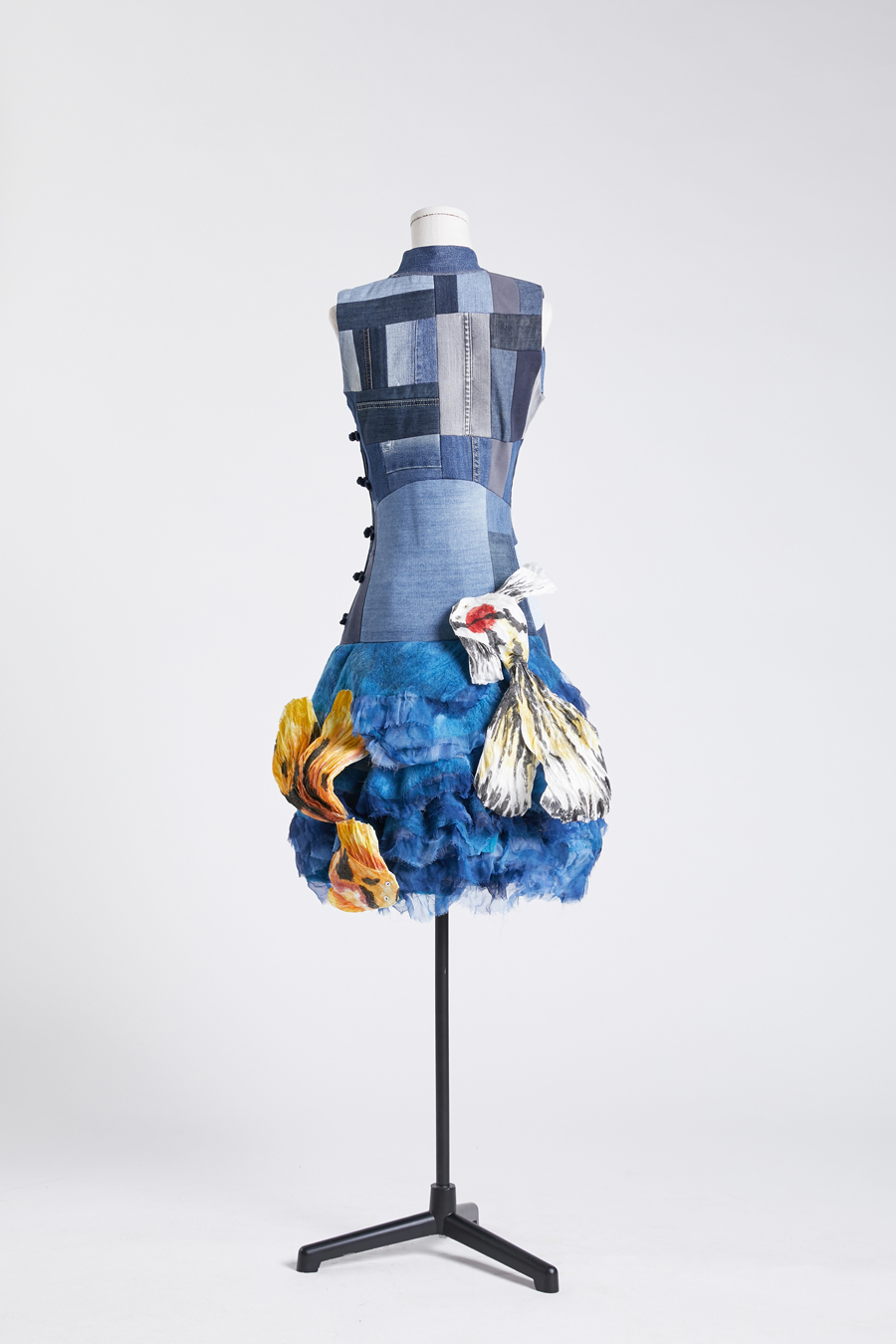
20. Born From a Cocoon - Svetlana Gromik Venger
The beauty of silk fabric is fascinating, and the history of silk reminds a fairy tale. This fabric is created by nature for shine, joy and dance. A dress that was born of silk is an ode to the craftsmen who, using their own hands, turn a cocoon into a thin web of fibers and afterwards into a magnificent fabric. Watching the work of the craftsmen, stretching silk cocoons into fibers, the idea came up of creating a dress that would tell a story about Chinese craftsmen creating silk for thousands of years. This is not just a fabric manufacturing process; it is a thousand-year history and culture of the people who gave the world a material unique in its properties and beauty.
Svetlana Gromik Venger
Born in Ukraine and based in Madrid since 2001. Forward I moved to Spain, I have become a member of textile artist’s association from Madrid since 2019.
From childhood, I've always been impressed by textile art. So, ever since I discovered felting, I became simply enchanted by it. I have considered myself to be self-taught textile artist for the last 10 years. I love mixing wool with other textile materials to obtain new textures and forms. As a contemporary artist I use a traditional felt technic mixed with other materials to express my ideas. I have working with costume designers using felt technique to create theatrical costumes. As a felt maker I teach workshops in Spain. My works were selected for several national and international textile exhibitions.
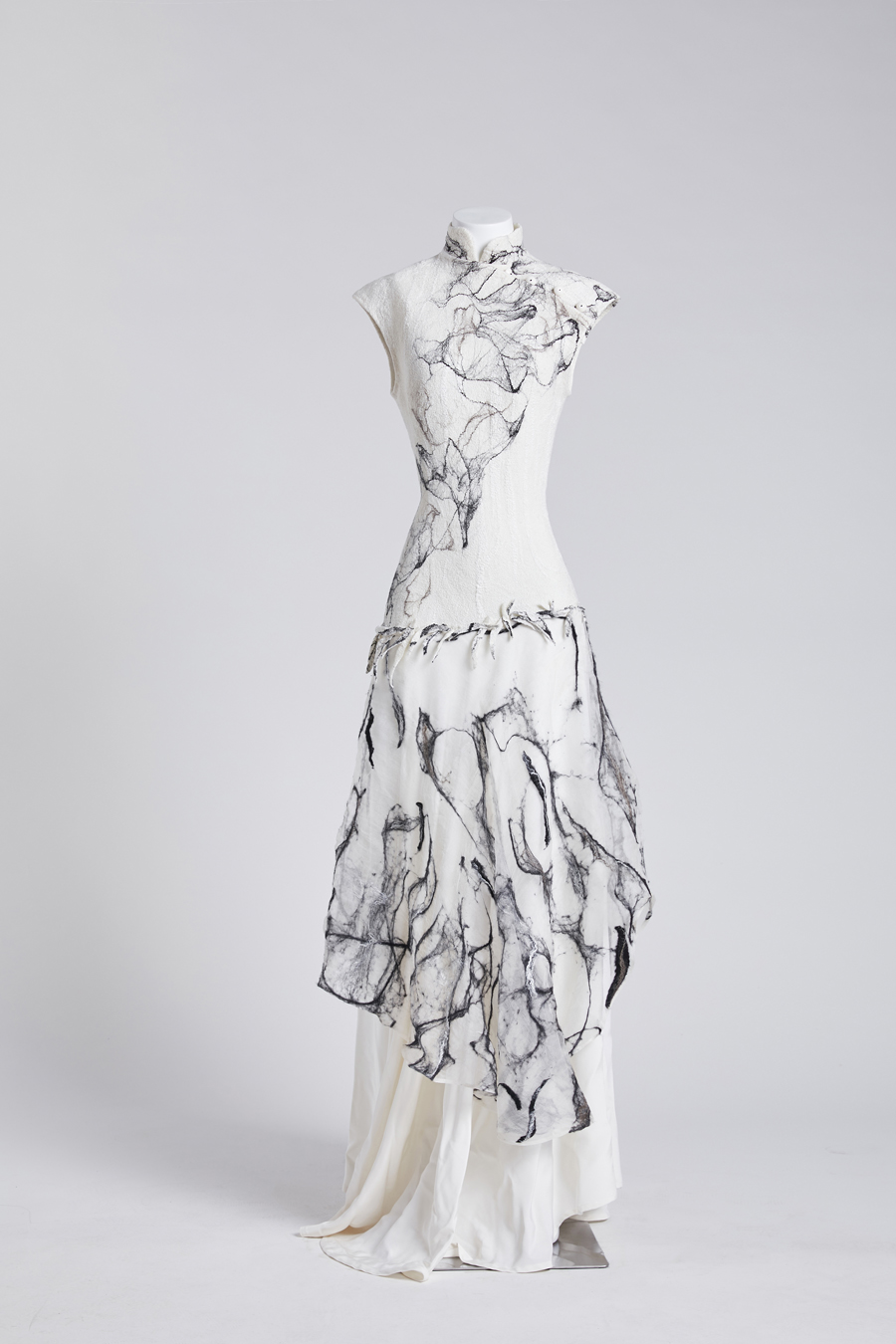
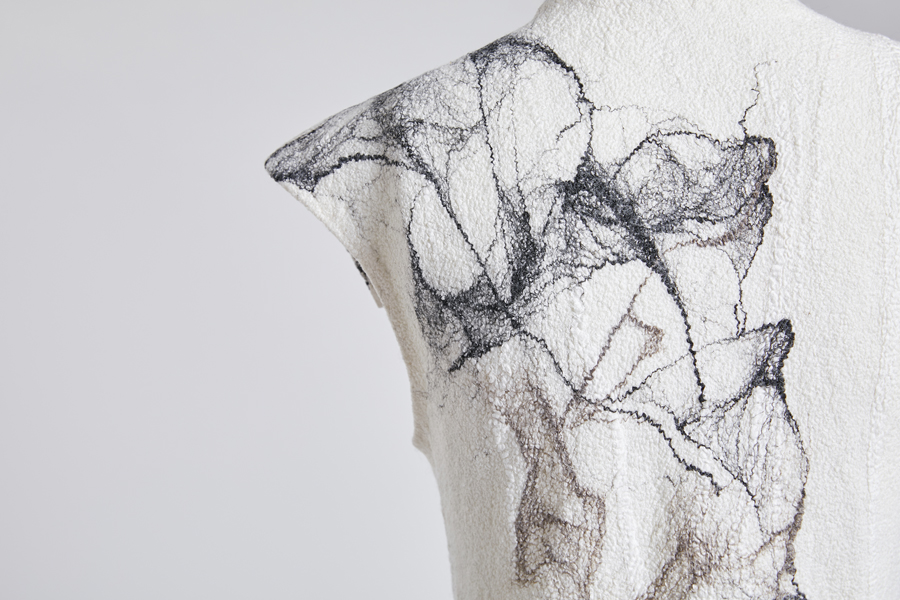
21. THE PERFECT DANCE - Svetlana Gromik Venger
Qipao is an elegant minimalism, noble and aristocratic. Flamenco is expressiveness and passionate splendor. What is common between these two national costumes and these two cultures? In my work, I tried to answer this question by combining two cultures in one craftwork. The cultures are so different but this they complement each other so harmoniously.
Svetlana Gromik Venger
Born in Ukraine and based in Madrid since 2001. Forward I moved to Spain, I have become a member of textile artist’s association from Madrid since 2019.
From childhood, I've always been impressed by textile art. So, ever since I discovered felting, I became simply enchanted by it. I have considered myself to be self-taught textile artist for the last 10 years. I love mixing wool with other textile materials to obtain new textures and forms. As a contemporary artist I use a traditional felt technic mixed with other materials to express my ideas. I have working with costume designers using felt technique to create theatrical costumes. As a felt maker I teach workshops in Spain. My works were selected for several national and international textile exhibitions.
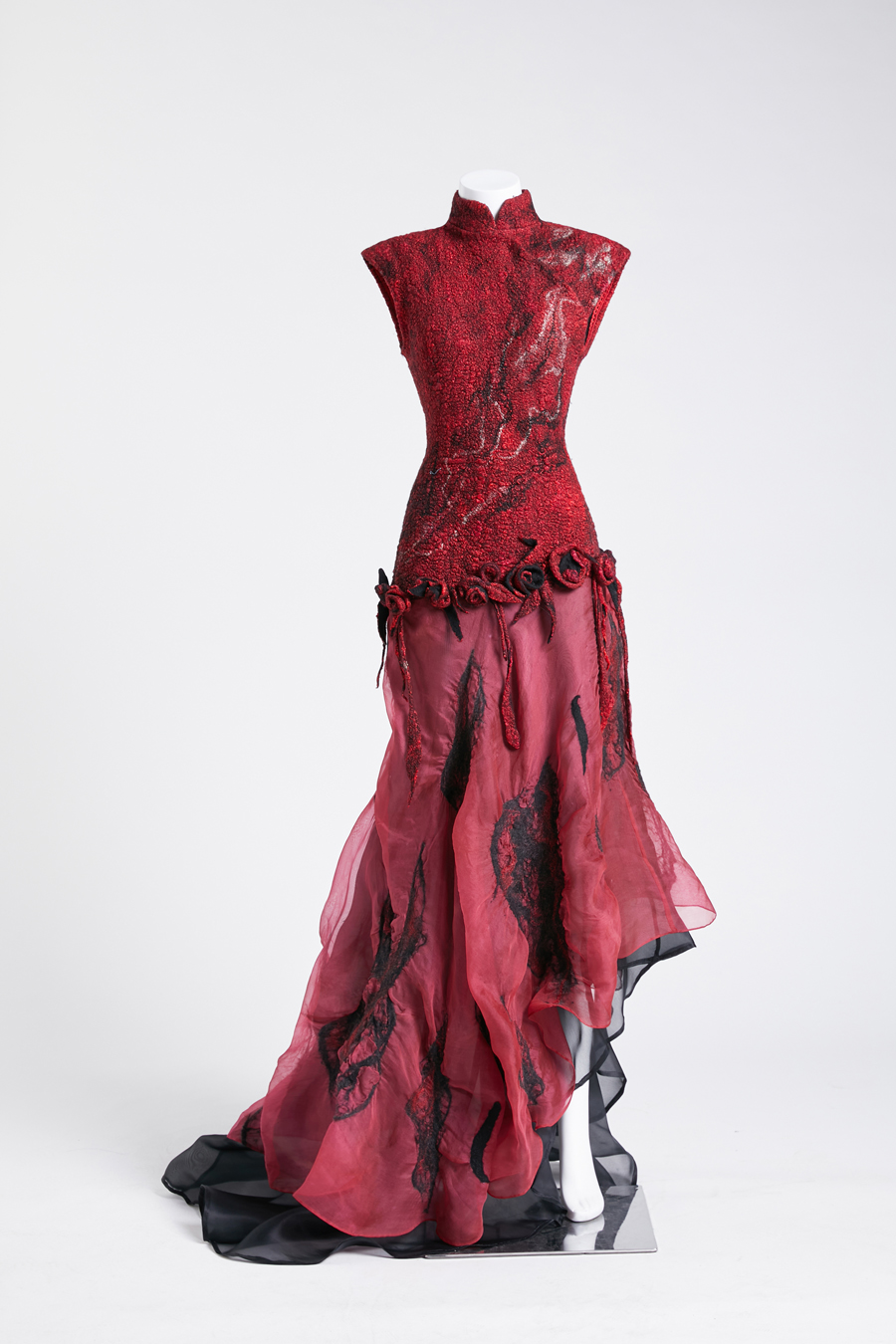
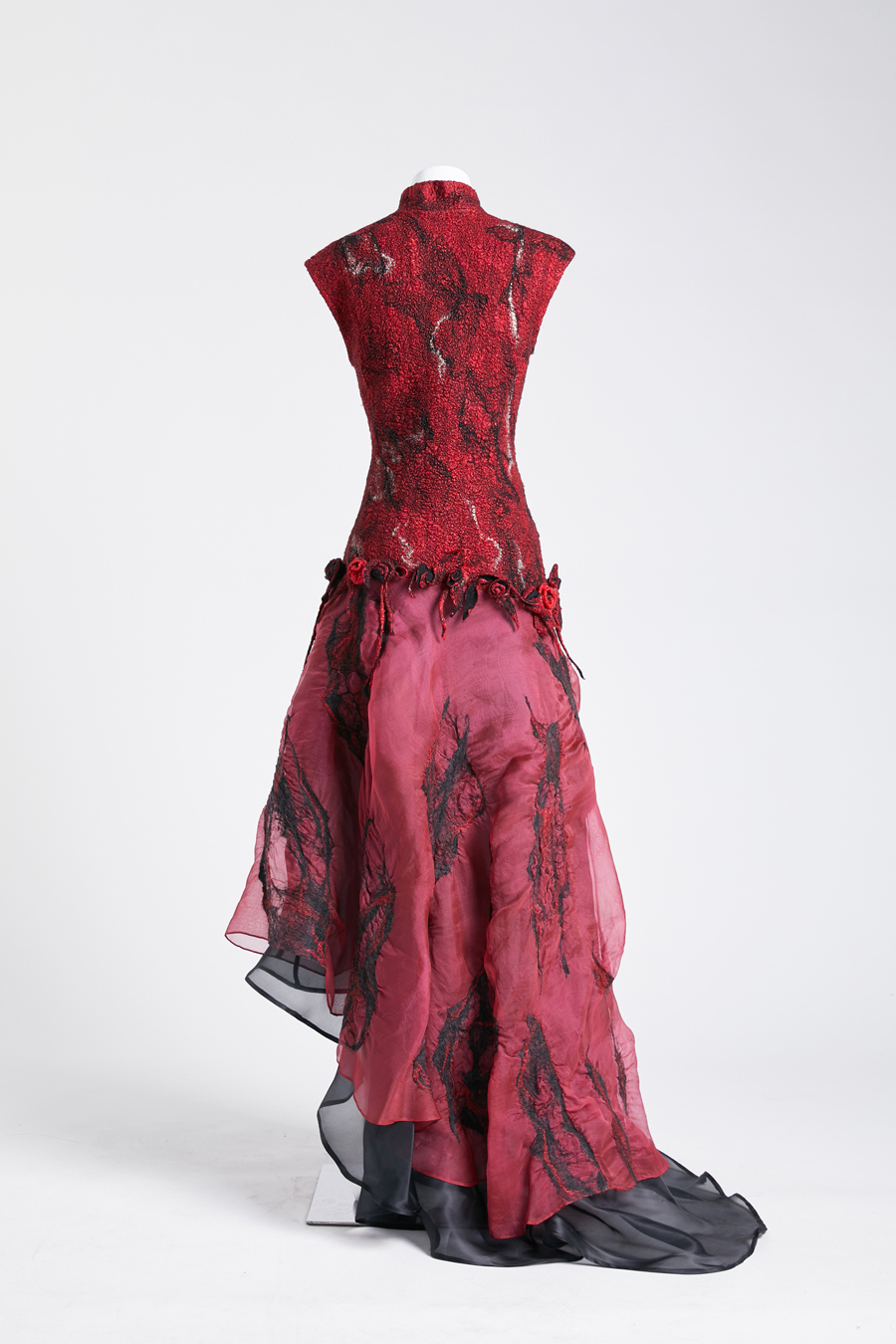
22. Poetry...Flight - Dinka Kasabova
Qipao's garment is a balanced mixture between history and new culture, a feeling of tenderness and a graceful silhouette with fine floral designs. The interesting history of Qipao, which becomes a phenomenon in fashion culture from 1920s to 1940s in Shanghai, is connected to a new modern point of a new modern point of view about the emancipation of woman.
"FLYING" is my vision of opening the spirit to new awareness and self-reinvention. The design was created from natural materials, silk and organza. In one full vision the garment has been treated with special technique and ways of sewing, through creating pleats. There will also be an addition of a textile print, which also favors the "poetic flight" theme. The opinion that "our beautiful nature is the most authentic and suitable way to reflect the human soul" is the reason why I choose butterflies as patterns.
Dinka Kasabova
ln my designs l always strive to pursue the idea of"slowness". It is of utmost importance for me that the piece of clothing, in its final form, creates positive emotions in the customer. I have graduated the National Academy of Arts in Bulgaria with a degree in Textile Design and l find my passion in experimenting in the field of textile stamping. For that reason,when creating a piece of clothing with a given topic, l always decide on the stamp first and what I can express through it. By believing history can teach us a lot, I use traditional techniques for treatment of fabrics. However, it is always beneficial to blend them with your personal experience.
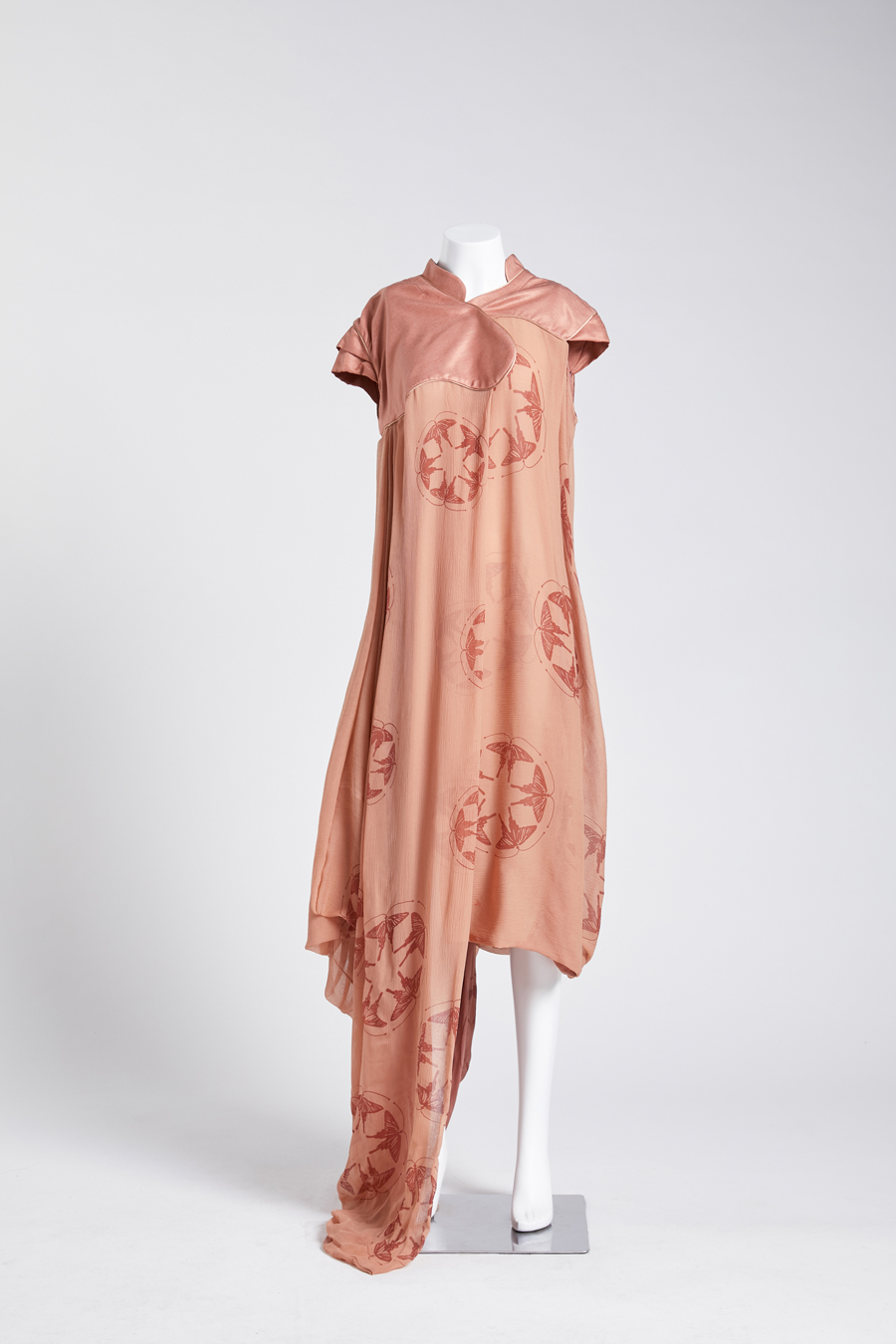

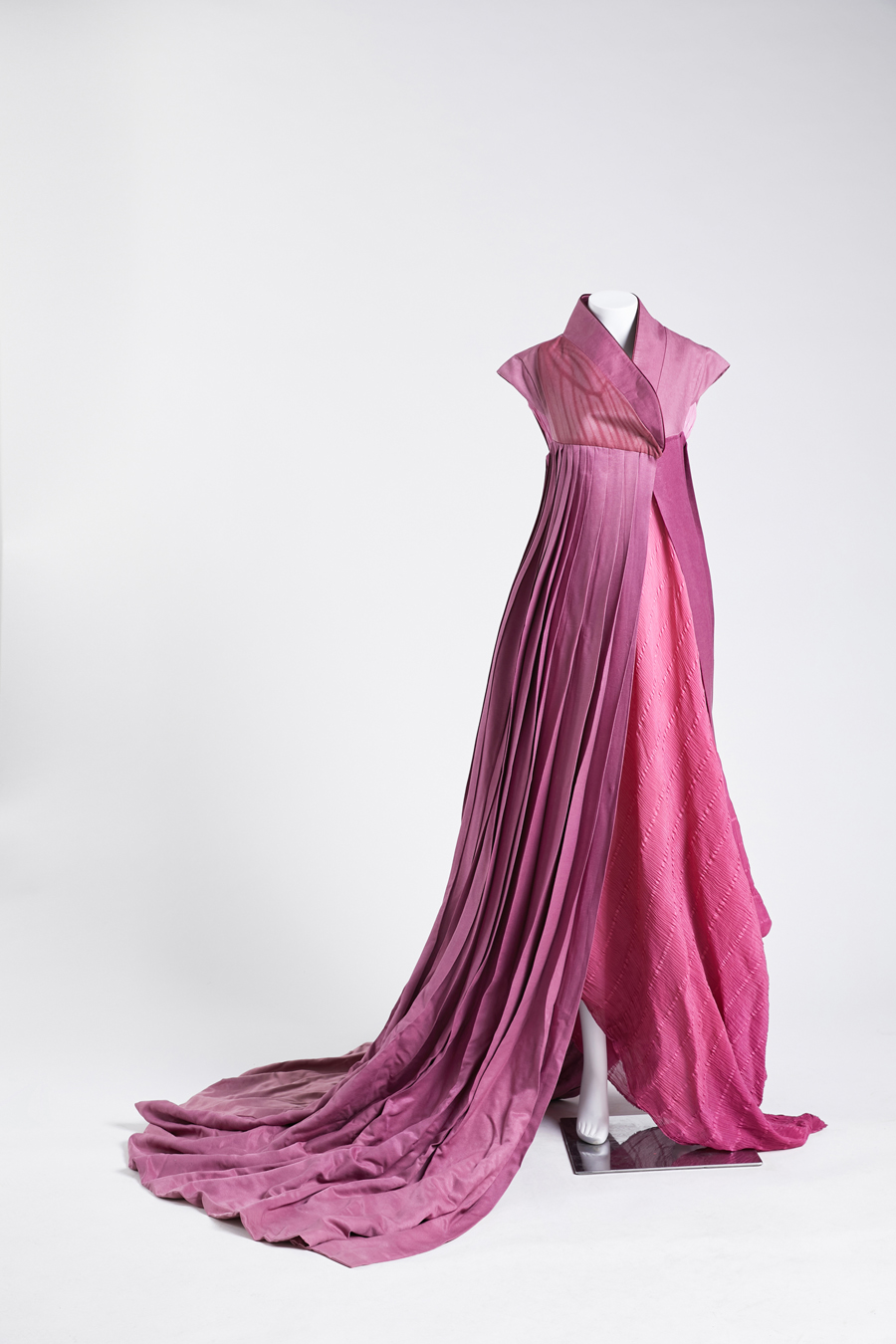
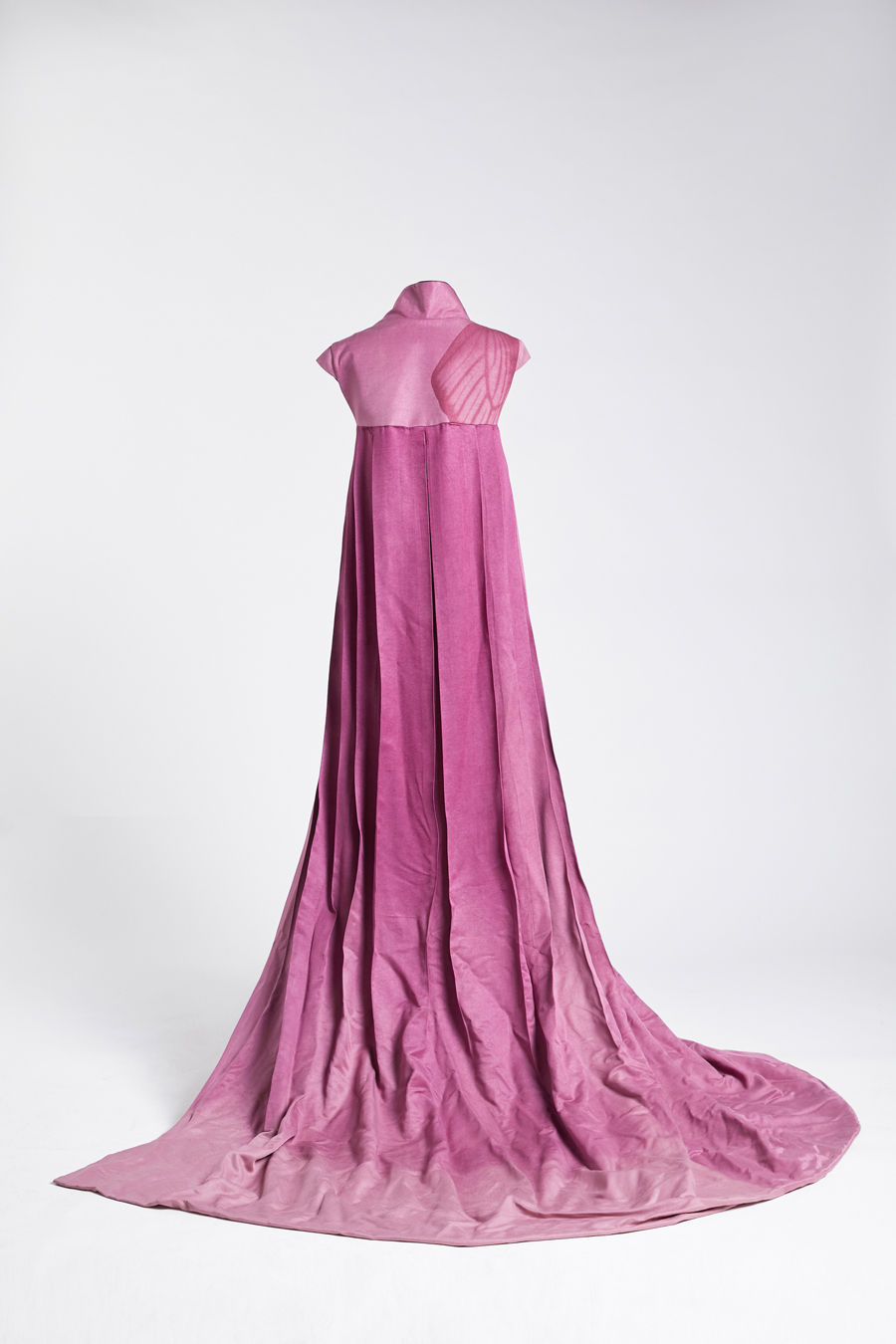
23. Everlasting - Ma Yiyun
This Qipao is inspired by Guo Moruo's Market in the Sky, a poem that describes an endless fantasy of the universe. Do we have a chance to visit the market with lanterns hanging? Can we explore the infinite universe? I combined the poem with the movie Star Trek, which tells a story of human beings searching for a new home outside solar system. In front of the universe, human beings are small and lonely. Time passes, space folds and changes, but only love transcends all dimensions and remains unchanged. That's why I named this Qipao "Everlasting".
Ma Yiyun, a current 3rd year student studying fashion design in Studio Gottelier, Shanghai Institute of visual arts. She is big fan of music and drawing. Music helps her to clear the mind and, Dali, one of her favorite surrealist artists, inspires her a lot in designing this Qipao.

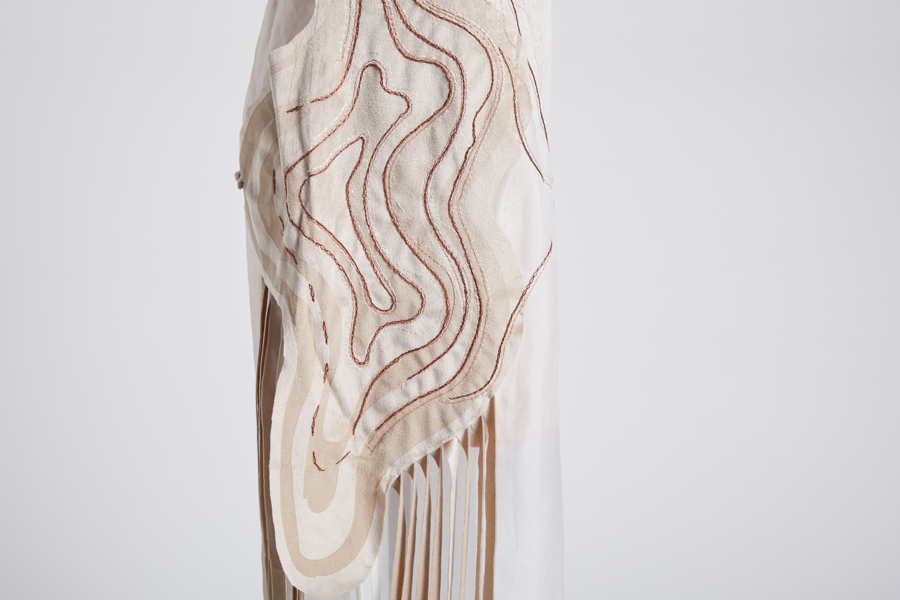
24. Old Memory as Poem – Małgorzata Czudak
Traditional Qipao dress, long, with stand-up collar and oblique closure, made of jacquard fabrics in classic Chinese motifs. I decided to leave the classical form, but use other means to implement it. Characteristic for Polish culture. The bottom of the dress is weaved, just like the rugs of Agnieszka's my grandmother, which I remembered from her childhood. For this, I use scraps of fabric, which is included in the price, from my collection. The upper part is also made by hand - the traditional method of hand knitting. I remember these handwork from my childhood. My mother knitted sweaters, scarves, hats in a temporarily available one, I don't even remember how much it was, original family sweaters have survived in the family archive. I quickly learned this method. During my studies I earned by making original accessories, hats, gloves and lace mittens.
In the upper part I introduce a thread of red thread. The top refers to Qipao, the stand-up collar will be included, because the stand-up collar was also popular in Polish culture. But I change it for golf.
Małgorzata Czudak
Clothing designer, MC identification mark, passionate about fashion and design. Skillfully combines theoretical knowledge with practical experience, acquired during cooperation with clothing companies. For several years, she has been preparing his own collections signed with the MCZUDAK brand is a minimalist by choice, reduces unnecessary elements. Functionality and practical details are very important to her. It focuses on high quality - workmanship and fabrics used rather than mass production. She values traditional crafts and manual work. Her clothes are designed with pleasure for the pleasure of the people wearing them.
bądź przy mnie blisko
bo tylko wtedy
nie jest mi zimno
chłód wieje z przestrzeni
kiedy myślę
jaka ona doża
i jaka ja
to mi trzeba
twoich dwóch ramion zamkniętych
dwóch promieni wszechświata
——HALINA POŚWIATOWSKA
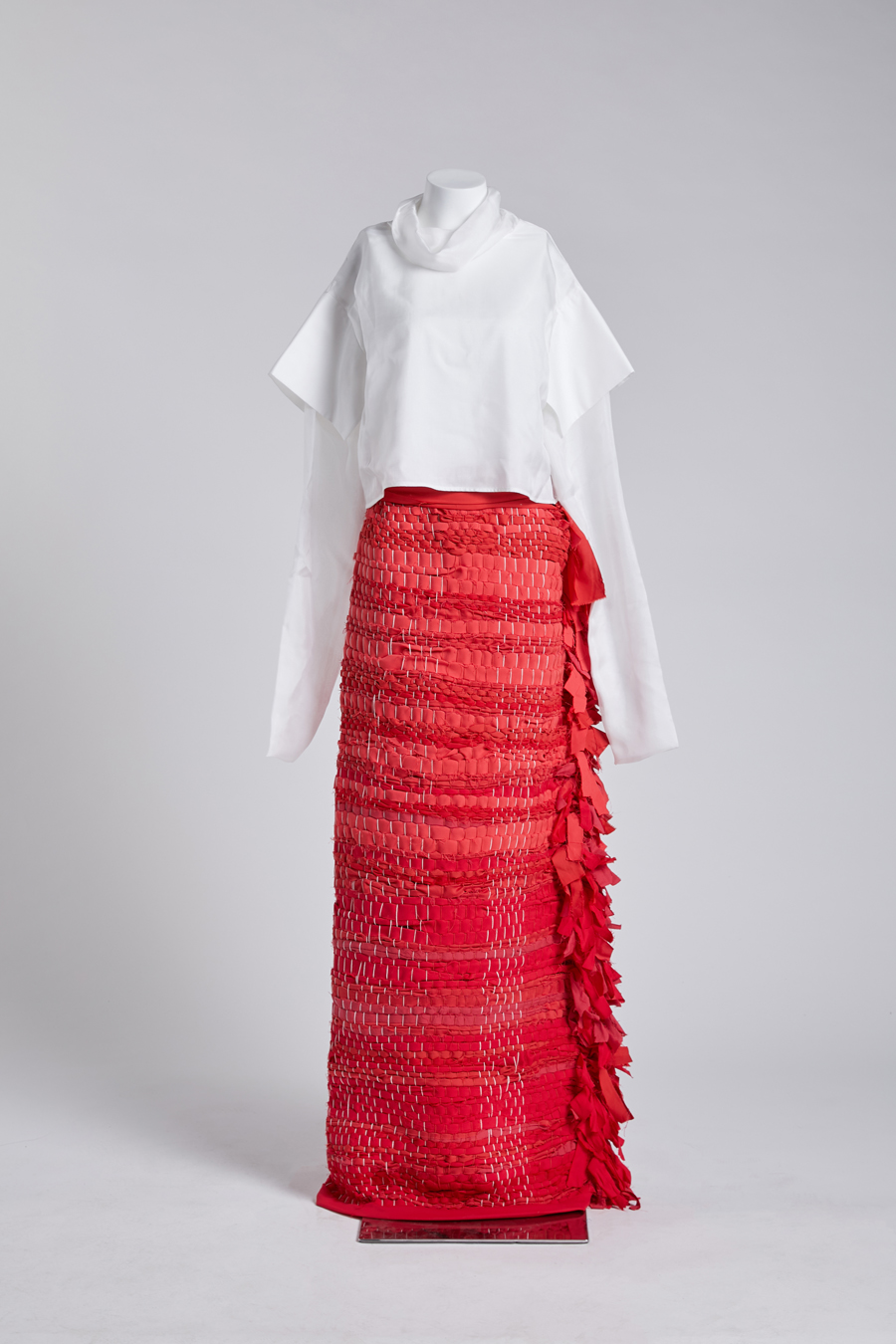
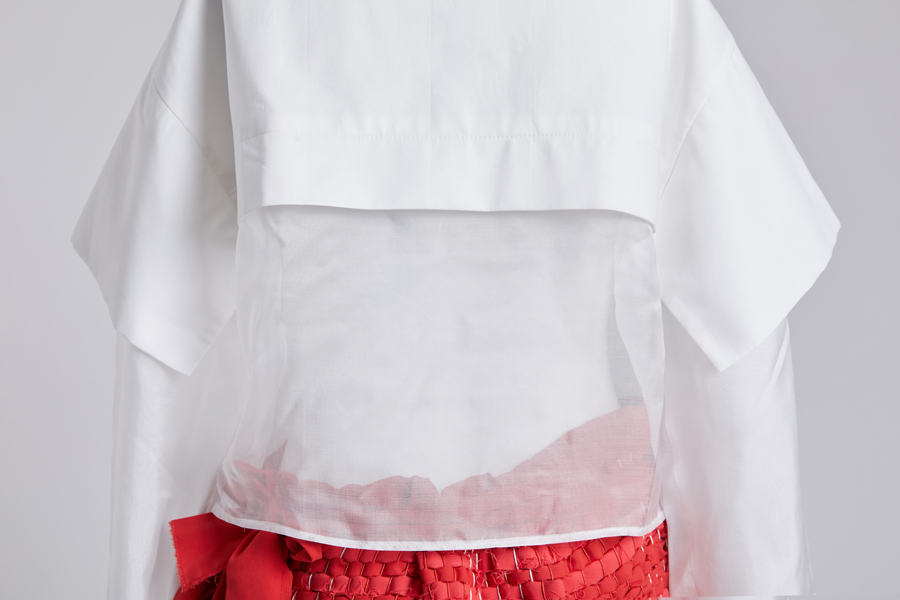
25. Halina – Małgorzata Czudak
The inspiration is the poems by my favorite poet - Halina Poświatowska. She wrote short, erotic poems. One of them is dedicated to loneliness. Lack of this beloved persons, her arms, warmth The feeling of coldness and loneliness, that's why sleeves in which you can hide your hands are important in the design. The dress envelops, gives a feeling of warmth and security, even if we are lonely. Instead of a classic stand-up collar - turtleneck, long sleeves in which you can hide your hands, wrap yourself. Feel the warmth and security.
Małgorzata Czudak
Clothing designer, MC identification mark, passionate about fashion and design. Skillfully combines theoretical knowledge with practical experience, acquired during cooperation with clothing companies. For several years, she has been preparing her own collections signed with the MCZUDAK brand is a minimalist by choice, reduces unnecessary elements. Functionality and practical details are very important to her. It focuses on high quality - workmanship and fabrics used rather than mass production. She values traditional crafts and manual work. Her clothes are designed with pleasure for the pleasure of the people wearing them.
bez ciebie jak
bez uśmiechu
niebo pochmurnieje
słońce
wstaje tak wolno
przeciera oczy
zaspanymi dłońmi
dzień - szeptem
modlę się do uśpionego nieba
o zwykły chleb miłości
——HALINA POŚWIATOWSKA
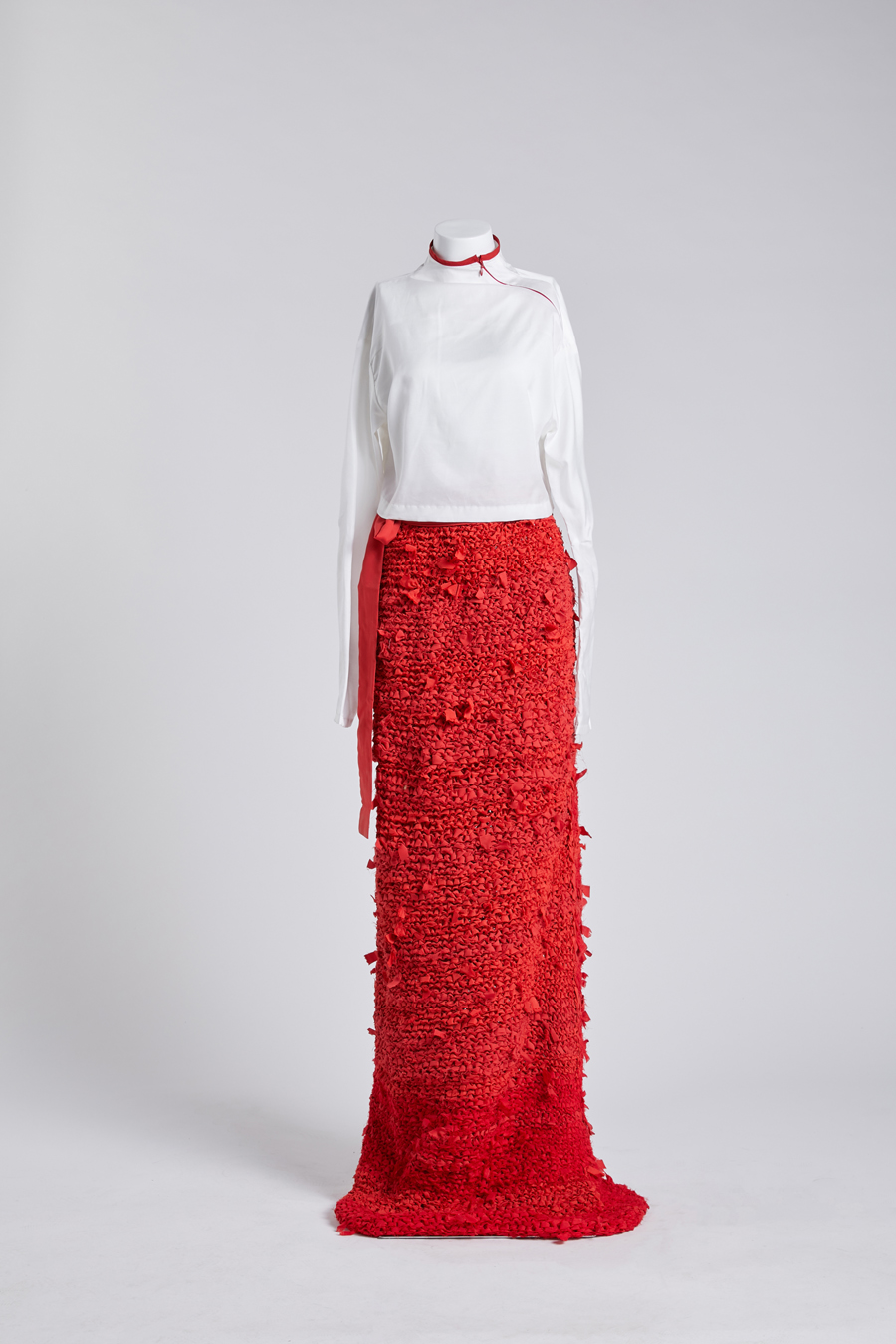
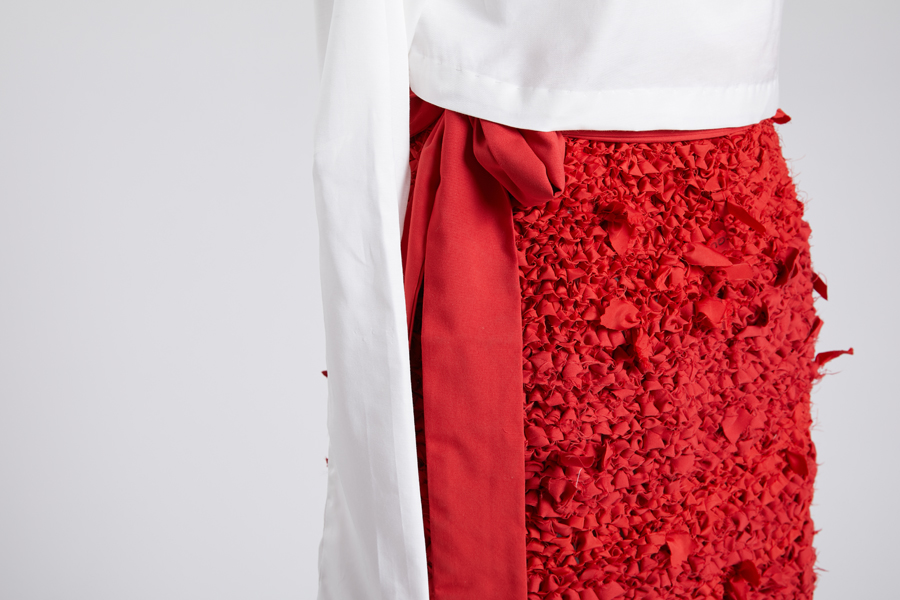
26. Cambodia-China Friendship - Tex Simheang
Qipao is of great significance, combining Khmer culture and Chinese culture.I designed the silk Cheongsam Hol skirt is based on the wall of Angkor Wat with a history of more than 1,000 years. The Hol skirt is the traditional dress of Cambodia, woven from silk. The flower inside is the Phka Chan flower, which looks like a Chinese coin.Its four colors have the relationship between the Cambodian flag and the Chinese flag. The blue and red is the Cambodian flag, and the yellow and red is the Chinese flag. Its name is "Cambodia-China Friendship".The design of the Hol skirt is operated by hand. We need to design it. After the design is completed, we need to interweave it into flowers. Next we need to dye it one by one. We dye it by hand, and then we interweave the woven fabric and install it on the woven fabric and put it on the loom for weaving.
Tex Simheang is the founder of the Kei Meas and a designer who loves ancient and modern designs. She once received a training project aided by the German government and had received training twice before and after. She also went to China in 2018 to attend a training course on modern design.
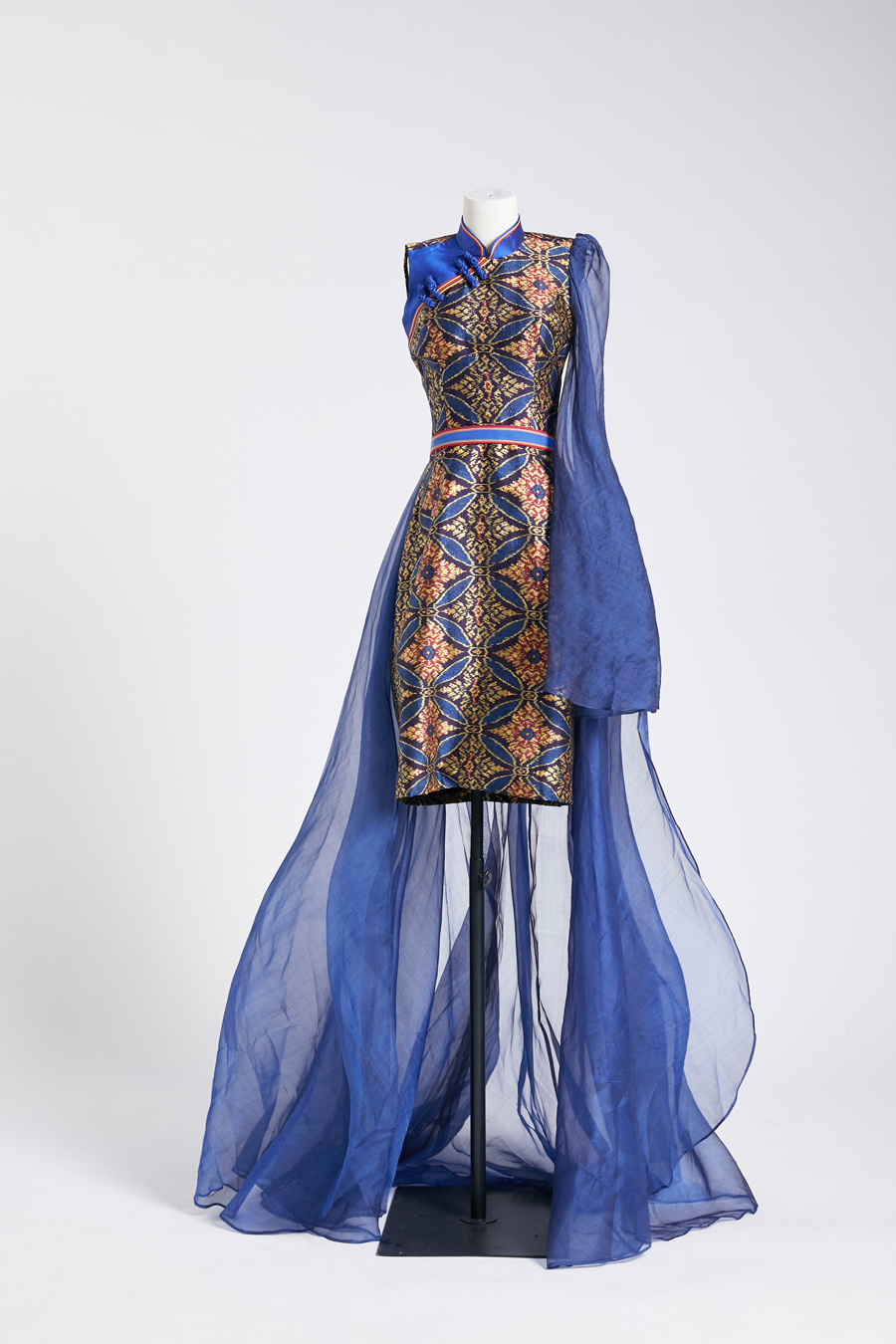
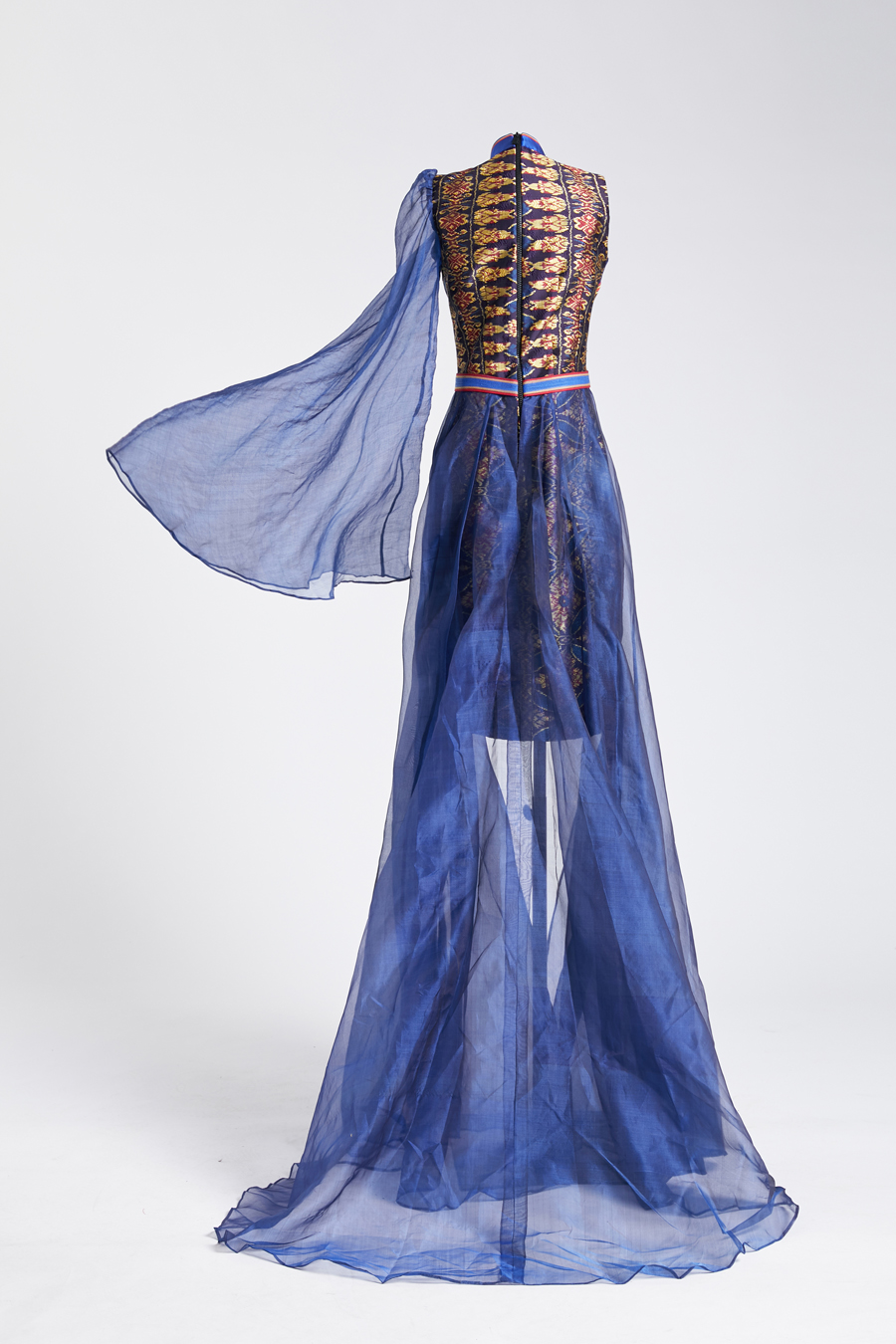
Unit 3 Fashion of the Octopath
Nowadays, the modern society create chances for us to communicate to the world. Fashion is coming from one place to another by networks, changing people’s life and everything, including poetry. Every person is able to become a poet to pass their voice and thoughts through all the paths. Fashion is one of the forms representing poetry, which showing designers’ poetic inspiration.
27. Resonance – Dafna Stoilkova
This design explores the poetry found in the harmony of dualities.The idea is to create an extraordinary Qipao garment, which beauty is the balance between pattern simplicity and rich surface texture. The silhouette is both classically tight fitting and contemporary due to the innovative laser cut structure. This play creates a timeless elegance.The harmony of dualities is underlined by the combination of complementary colors.
Dafna Stoilkova is an artist and designer working in the fields of fashion, textiles and painting. She has gained her education in Fashion design at the National Academy f Arts, Sofia and at the Art Academy Weissensee, Berlin. Currently she is a PhD student in Textile art and design at the National Academy of Arts, Sofia.
She has studied both traditional and contemporary textile and garment construction techniques. In her design work she explores the relation of structure, function and perception through experimenting with structures and materials.Dafna has two solo exhibitions of aquarelle paintings at Gallery Spazio, Sofia. She presented her graduation collection during Designblok 2014 in Prague. She has experience in moderating workshops.Her interests include mathematics, biology, biomimetics, crystallography, material science, ecology.
What sound is this? There is no sound at all
I listen to something deep inside
Did you see it?
There is nothing to be seen
It is obvious but imperceivable
The matter
Isn’t matter at all that’s all that matters
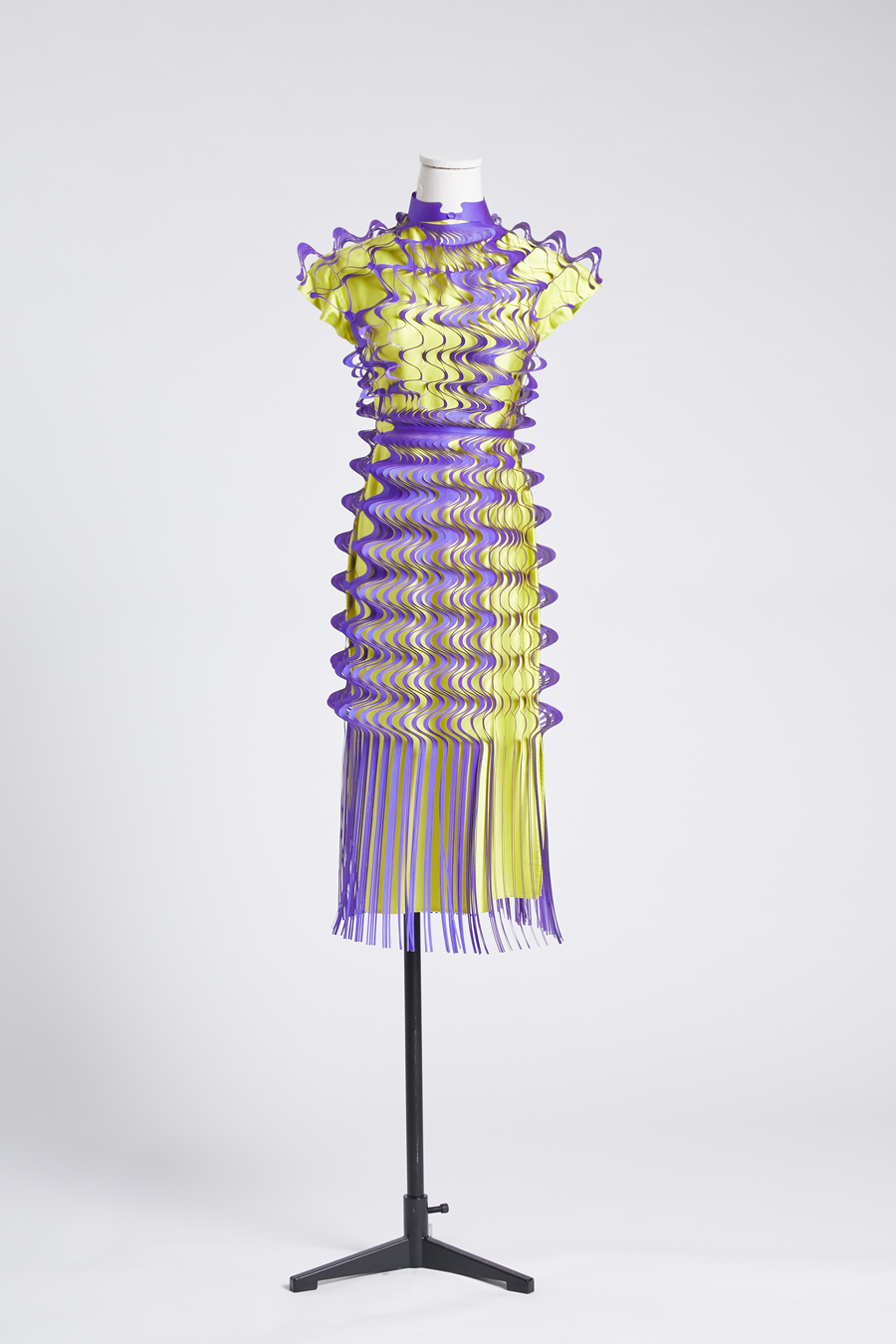
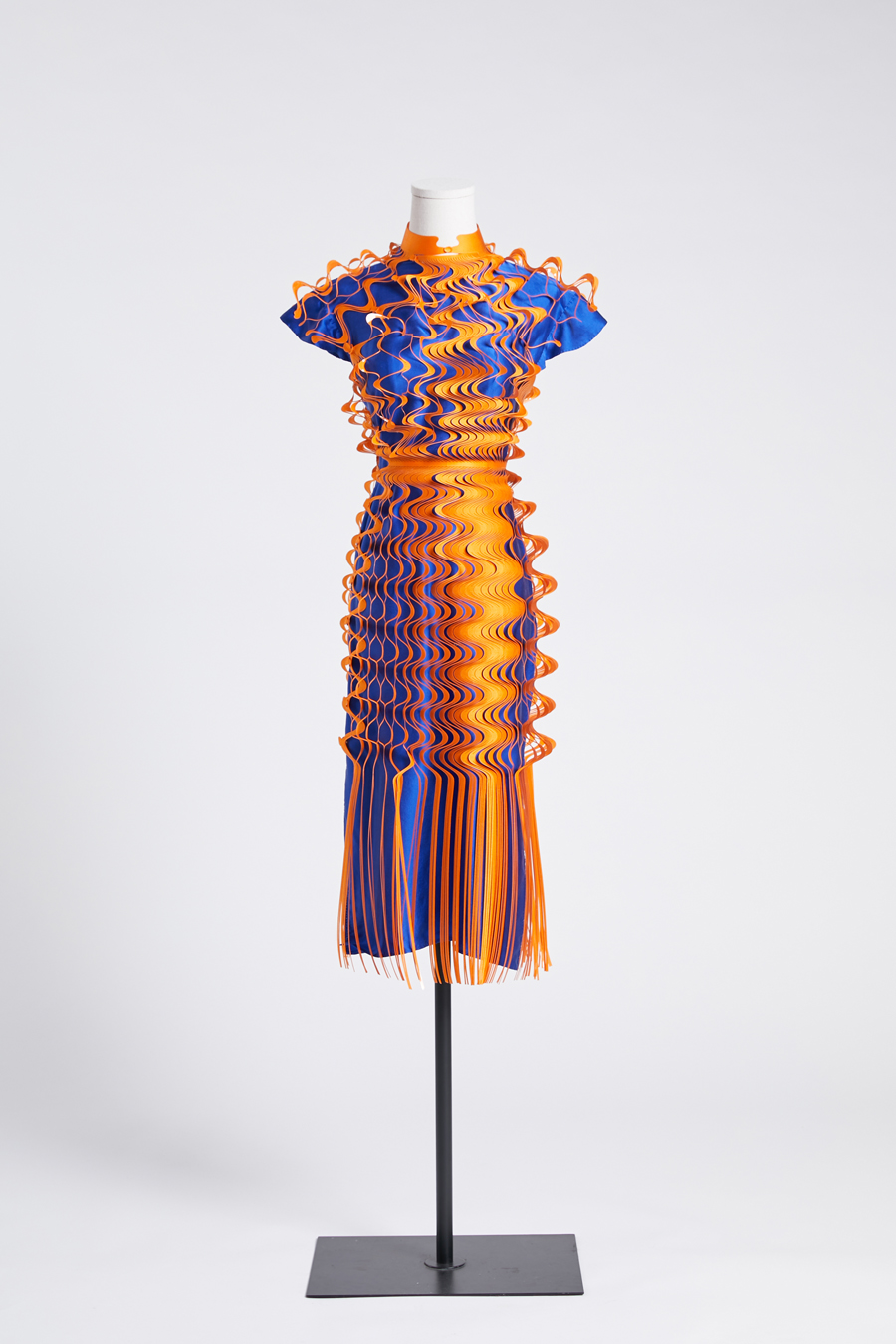
28. Texture Prescription – Uma Wang
This Qipao is covered in pure white. The flying sleeves create a silhouette of modern. It is a modification to the classic Qipao shape, the long ribbon links with the lower part of the dress, offers a flexible appeal to the original. Jacquard is the material that brings a strong sense to the dress, it is also the representation of the classical beauty aesthetics of Uma Wang.
Uma Wang trained at the Chinese Textile University in Shanghai and at Central Saint Martins in London. She launched her own label in 2009 and Italian Vogue proclaimed her an ‘up and coming talent’. Uma Wang’s signature technique fuses knits with fabric, balancing sophistication with a timeless design.
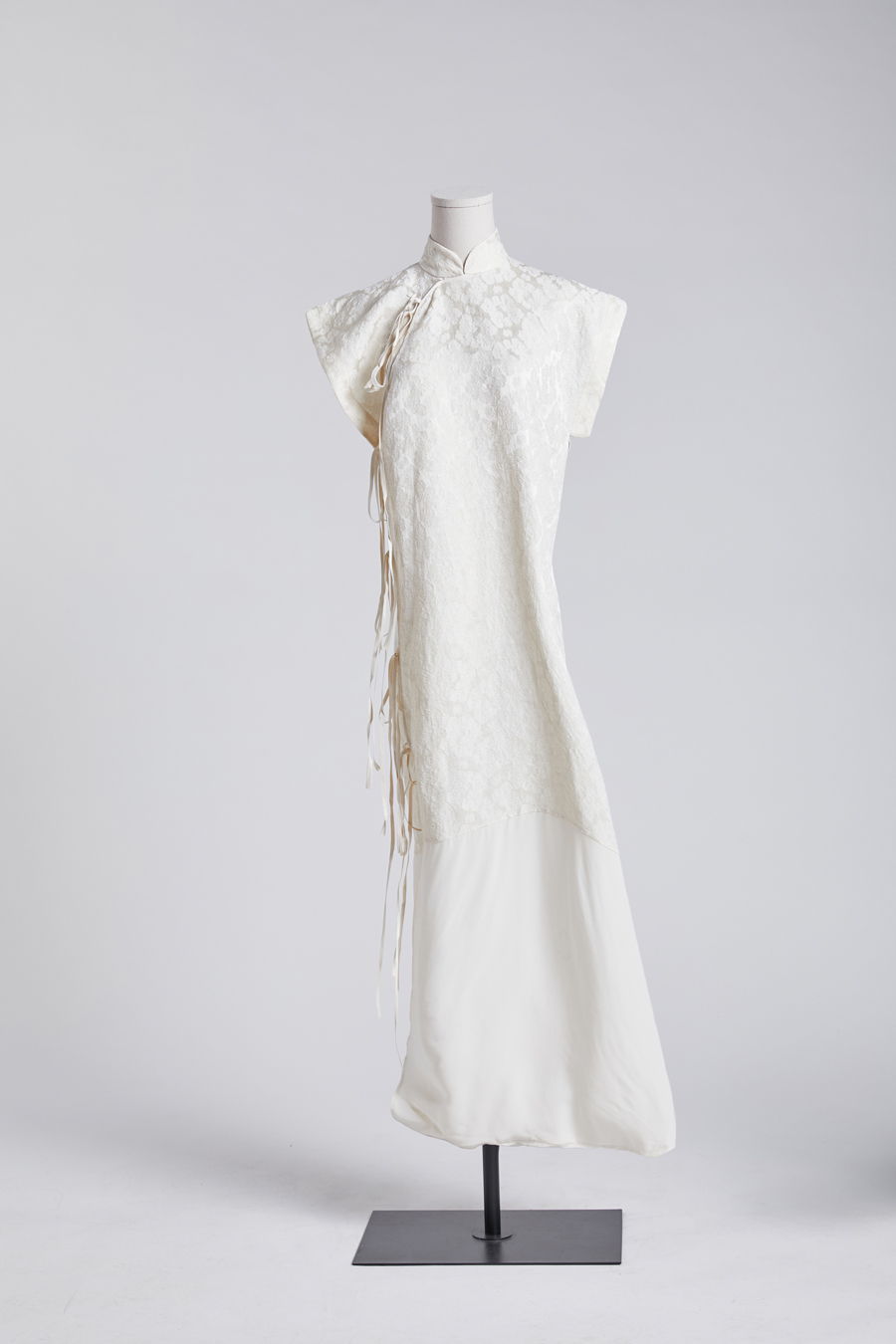
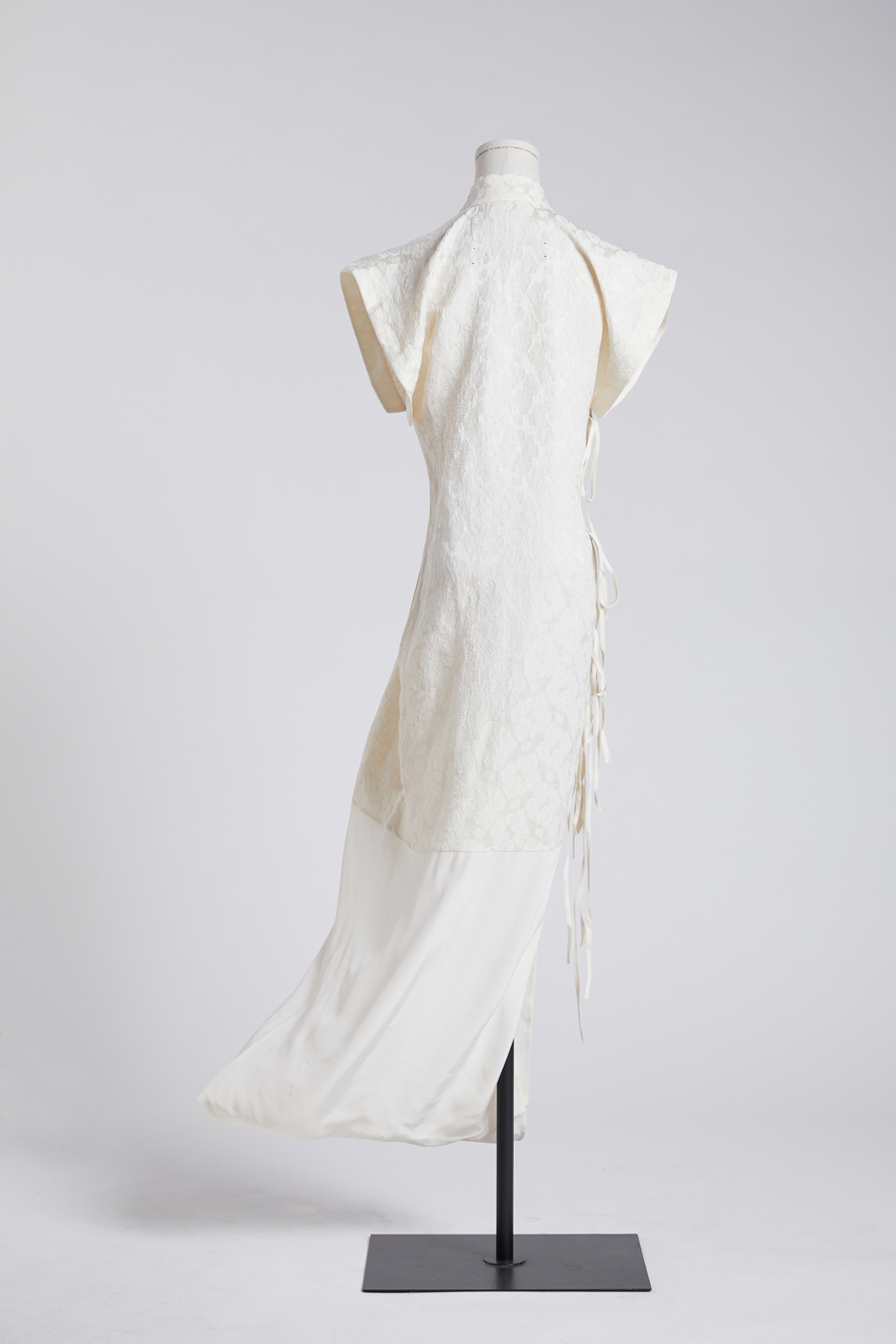
29. Old Dream at Sea – Fu Lanyue
Human is a micro-creature to the unmeasured universe. We lived in a busy speed so most of us even forget to definite the meaning of the clothes. I want to make clothes which can remain long forever, therefore, based on the inspiration of Art Deco, I have designed this Qipao series. I use leathers as the material. Leather stands for the building shapes after time passed. The Qipao series simplified the elements of building to combine the clothes and art perfectly, just as the past, Chinese culture and the Western culture have mixed into a new shape.
Fu lanyue, a Qipao designer graduated from the Department of fashion and fashion design of Tianjin Academy of fine arts, has participated in the production of Qipao in the provincial, regional and municipal global promotion project of the Ministry of foreign affairs of Tianjin. After I was admitted to the Academy of fine arts, I gradually fell in love with Chinese traditional culture and Qipao. In order to pursue the original intention of clothing and make more warm clothes instead of just cold industrial products, I studied the production technology of traditional flat cut Qipao of intangible cultural heritage from Mr. Mao Xuebai of Tianjin Institute of fashion research and Mr. Shi Liping of Tiangong Institute of Beijing Institute of fashion. I take the inheritance of Qipao as my future direction and make clothes that can be preserved in the world. I hope Chinese traditional culture and Qipao can have a long history under the efforts of our new generation.
The stars come and go, the universe moves, the spring and Autumn Period order, people die and life, the sun is infinite, the space is infinite.
——《A Gift to Kemu》Dai Wangshu
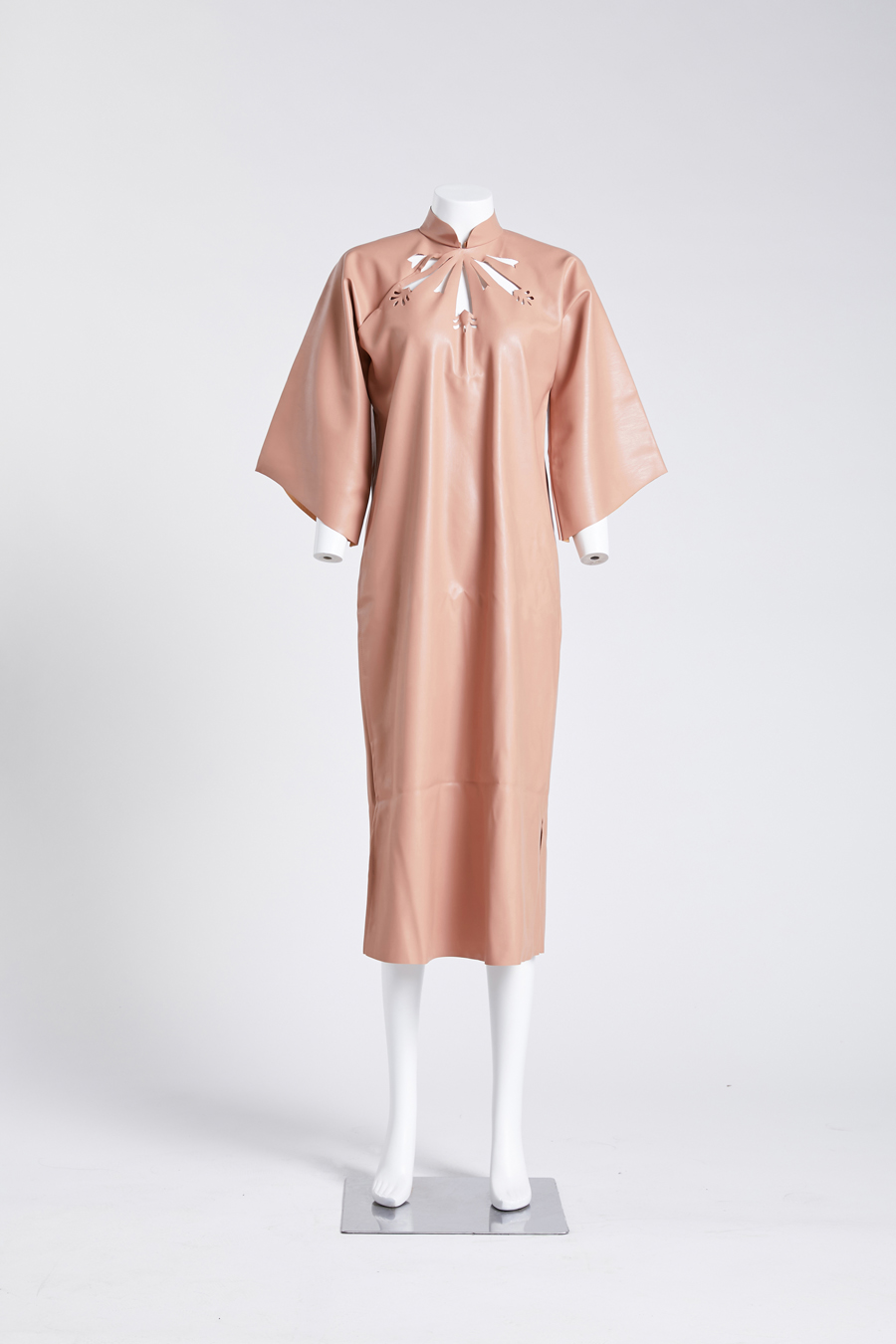


30. Love in a Fallen City - Chen Qiaoyan
This is a combination work done by several cultural heritages. A qipao with a cocoon-like outfit showing a classical appeal. The traditional line drawing artist drew the ancient maid appreciation, the Chao embroidery showing the solid patterns. The designer used the frog to create a larger movement for the outfit, showing the beauty and the grace of this Qipao.
Chen Qiaoyan
A Xiangyun Yarn Designer graduated from the Technics and Arts College of Fuzhou University, majored in Fashion Design. She created her own brand in 2004, and created her studio researching the technic of Xiangyun Yarn in 2010.
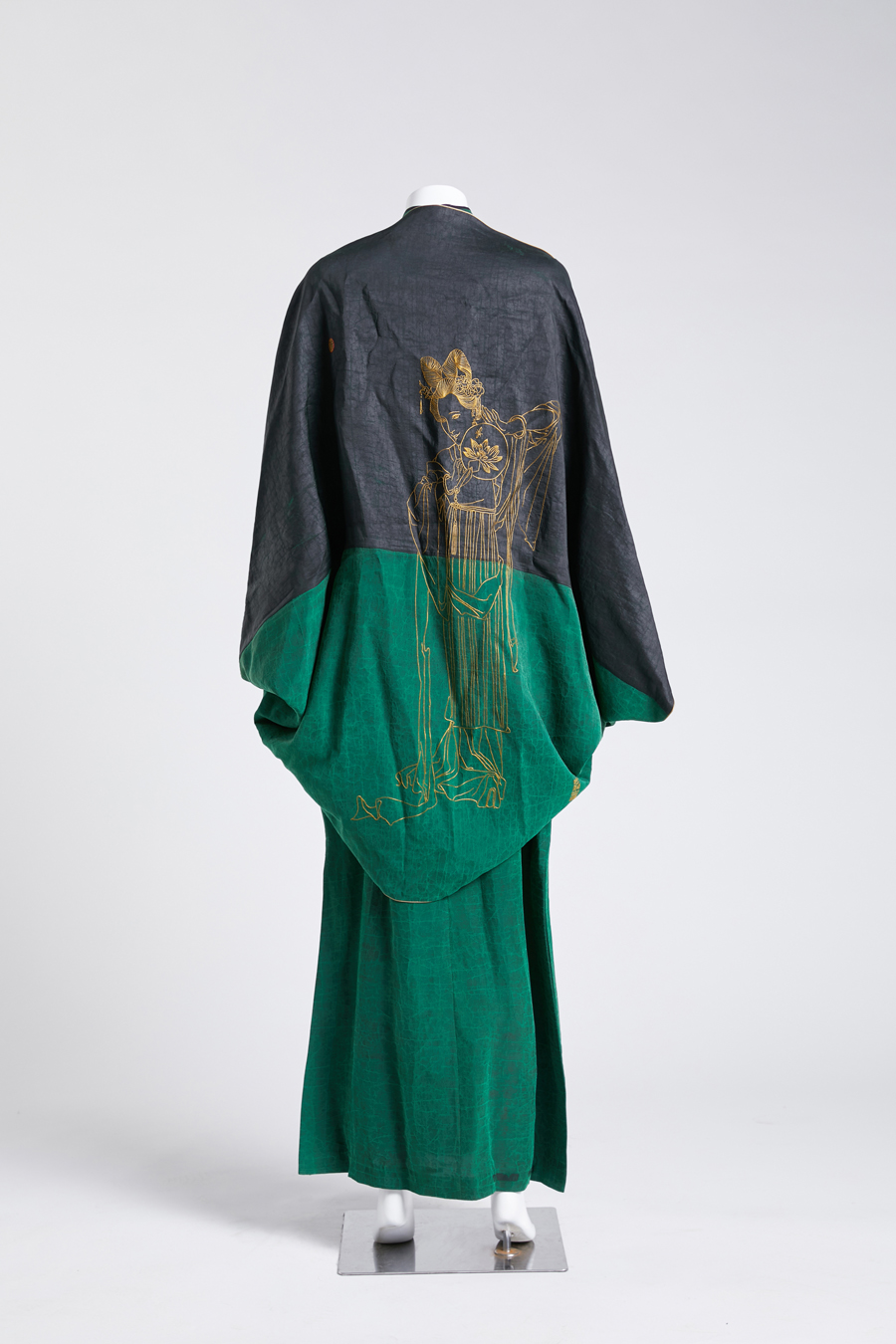
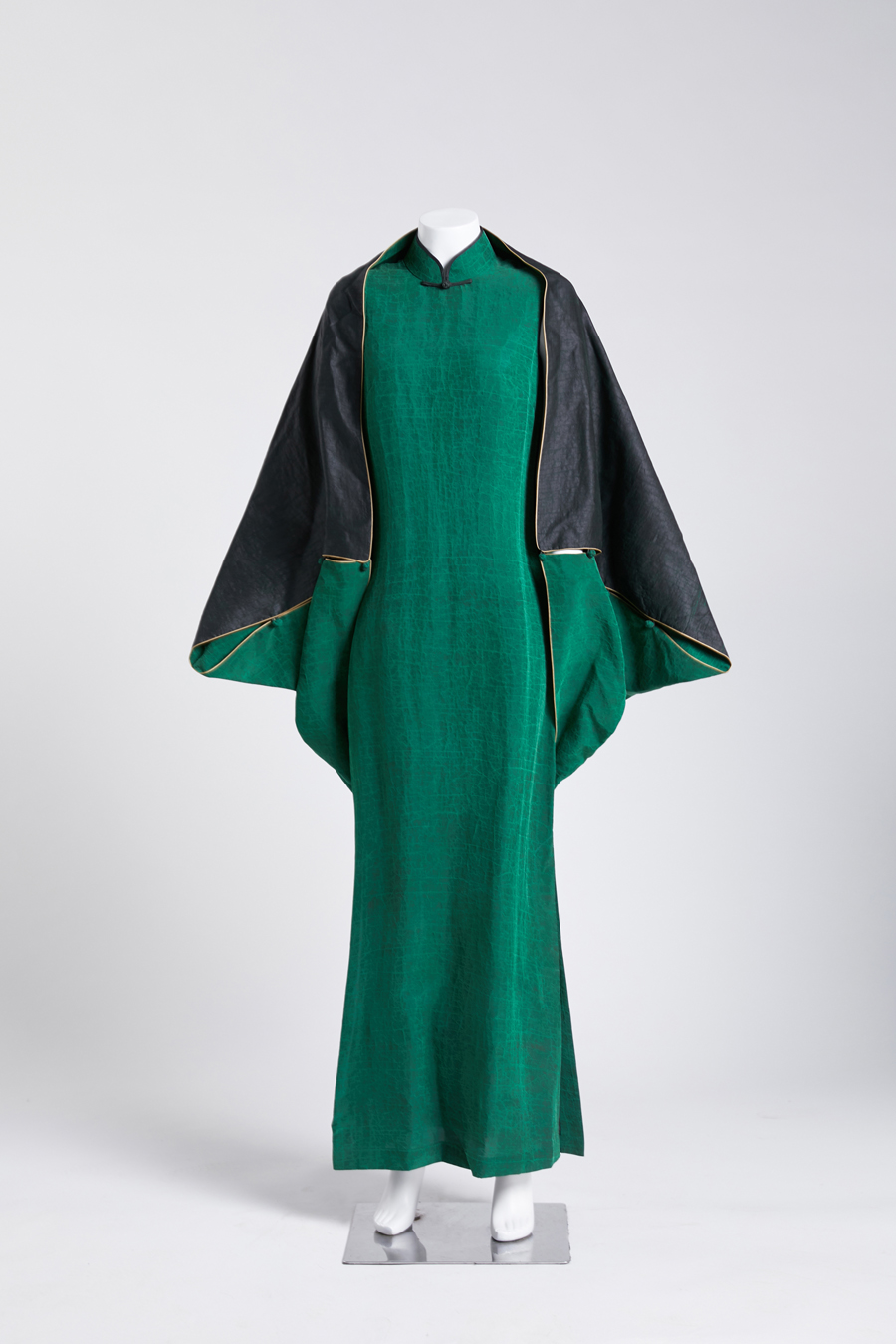
31. Heavenly Maids Scatter Blossoms – Chen Qiaoyan
This Qipao has combined the technic of Xiangyun yarn and traditional line drawing. Designer worked with the artist whose name is Zhan Zhongxiao to create this fantastic dress. The dress is asymmetrical to keep both the charm of traditional Qipao and also the simplicity of modern fashion. The Artist drew the line directly, showing the movement of a maid scattering flowers upside down, just like the painting in Dunhuang.
Chen Qiaoyan
A Xiangyun Yarn Designer graduated from the Technics and Arts College of Fuzhou University, majored in Fashion Design. She created her own brand in 2004, and created her studio researching the technic of Xiangyun Yarn in 2010.

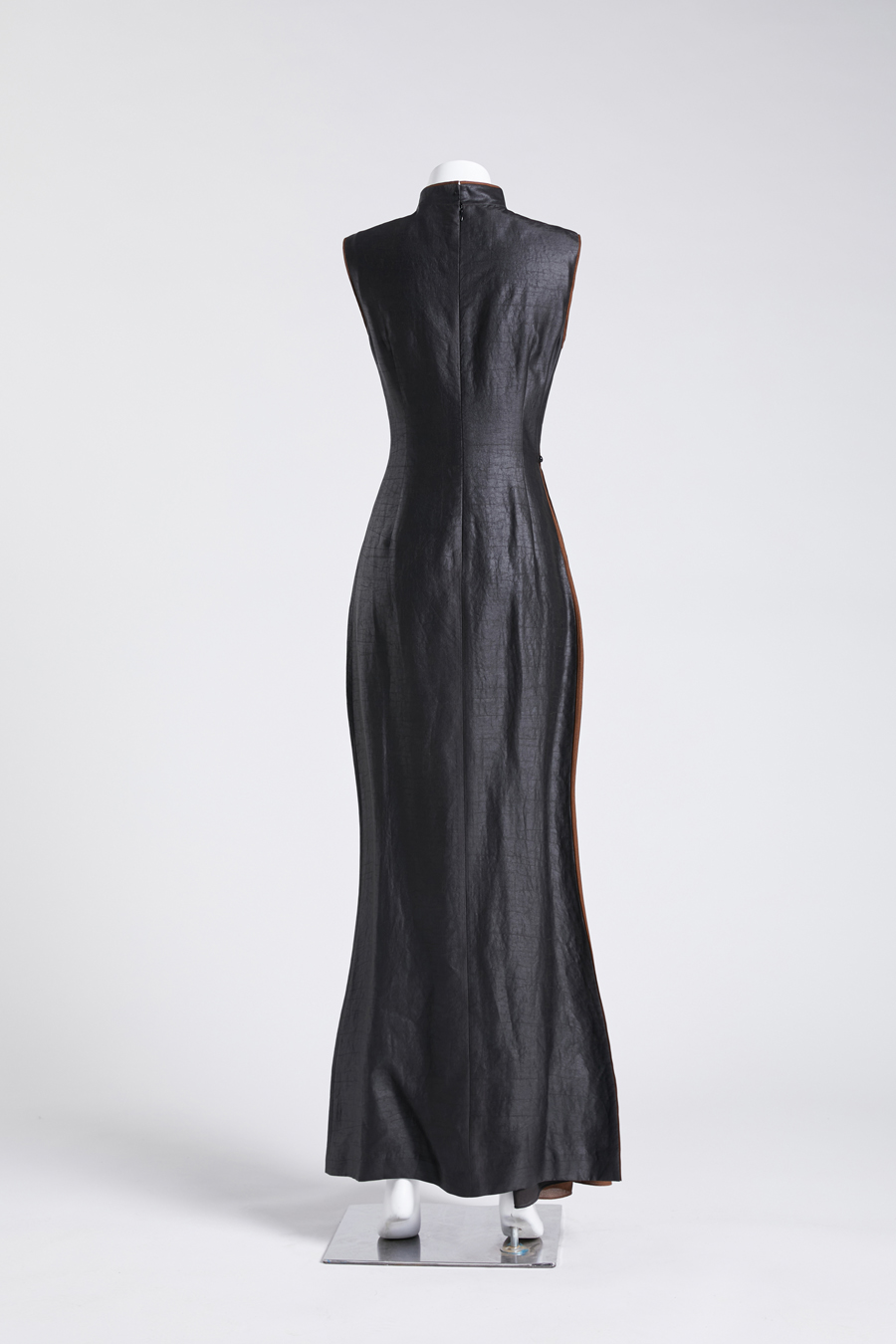
32. Live like Barbies - Hu Sheguang
Most people think Barbie doll is a symbol of luxury, but for the designer it is more of a lifestyle. The idea is to make the simplest clothing into unique texture. Designer uses non-traditional fabric design to break through the traditional Qipao, creating a fashionable Chinese Barbie, showing the collision of fashion and tradition.
Hu Sheguang is an haute couture designer. He has served as judge and art director of the competition Miss World, and Miss China of phoenix TV. He has also participated in many international fashion week and activities such as British, German and Dutch, and won many honors and awards.


33. Windy - Anna Elizabete Kasparsone
Silk satin one-piece dress with asymmetrical front opening (flowed line with small amber buttons) with traditional stand-up collar. Smoothness of the sea and air, nature held poetry inspired transparent silk organza volumed sleeves with amber embellishments. Slit on one side of the dress. Underneath transparent silk organza asymmetrical ruffle petticoat skirt layers, with amber embellishments for a stunning full look.
Anna Elizabete Kasparsone, designer behind the brand ANNA ELIZABETE FASHION, has obtained Masters degree in Art’s & Humanities (faculty of Design, department of Fashion Design) in Art Academy of Latvia. Previously educated in Riga Technical University, obtained Bachelor degree of Textile Technology and Design, speciality product designer. Collections have been presented in such contests as Habitus Baltija, Virus Mada, Fashion Manifestation, Riga Fashion Week and Maredimoda. ERASMUS+ mobility/internship (2018-2019) in London based luxury fashion labels. Participation in New Academy of Fine Arts (Milan) Summer School 18' / course in fashion marketing and management. Michelangelo Foundation Summer School Programme 19’ “Creativity and Craftsmanship” Aubusson/France and “ComON Creativity Sharing” project in Como, Italy.
The wind whistles past my ears.
Closing my eyes, I lose all my fears.
The waves crash into the rocks.
Out here there is no time on my clock.
—— “Beauty of Nature Poem”, Joshua Fraser
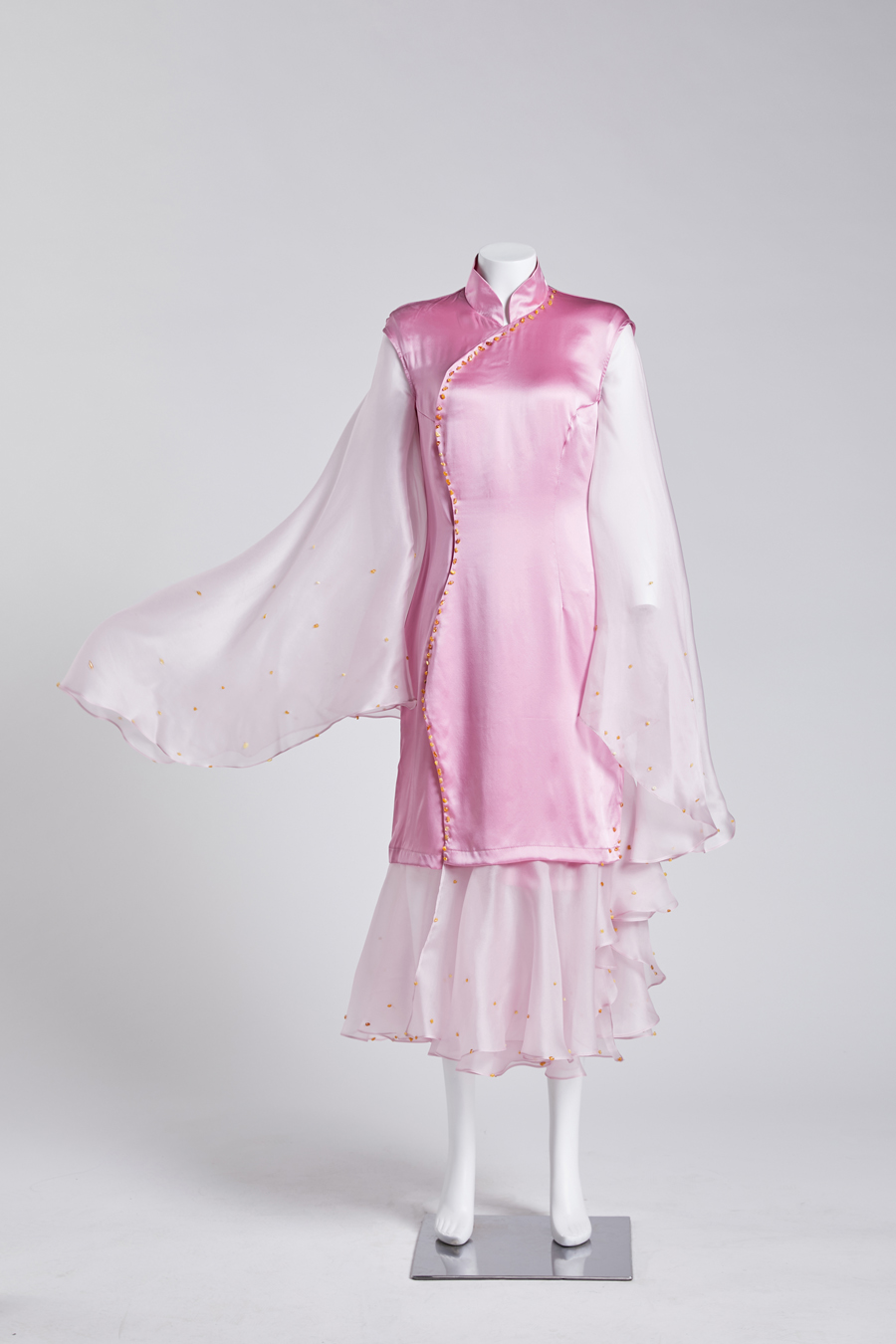

34. Amber - Anna Elizabete Kasparsone
This is a silk satin one-piece dress with asymmetrical front opening (fastened with small amber buttons) and traditional stand-up collar with amber embellishments. The dress is pleated, layered transparent silk organza sleeves. Upper worn pleated silk organza corset with long corset belt - displaying body contour. Sophisticated amber embellishments on dress and belt hem lines.
Anna Elizabete Kasparsone, designer behind the brand ANNA ELIZABETE FASHION, has obtained Masters degree in Art’s & Humanities (faculty of Design, department of Fashion Design) in Art Academy of Latvia. Previously educated in Riga Technical University, obtained Bachelor degree of Textile Technology and Design, speciality product designer. Collections have been presented in such contests as Habitus Baltija, Virus Mada, Fashion Manifestation, Riga Fashion Week and Maredimoda. ERASMUS+ mobility/internship (2018-2019) in London based luxury fashion labels. Participation in New Academy of Fine Arts (Milan) Summer School 18' / course in fashion marketing and management. Michelangelo Foundation Summer School Programme 19’ “Creativity and Craftsmanship” Aubusson/France and “ComON Creativity Sharing” project in Como, Italy.
The very air is amber to the touch.
Gnarled fingers trace the signature of warmth.
The slant of sun becomes significant.
Ribbons of west fall grosgrain on tin roofs.
—— “A Touch Of Amber”, Sandra Fowler
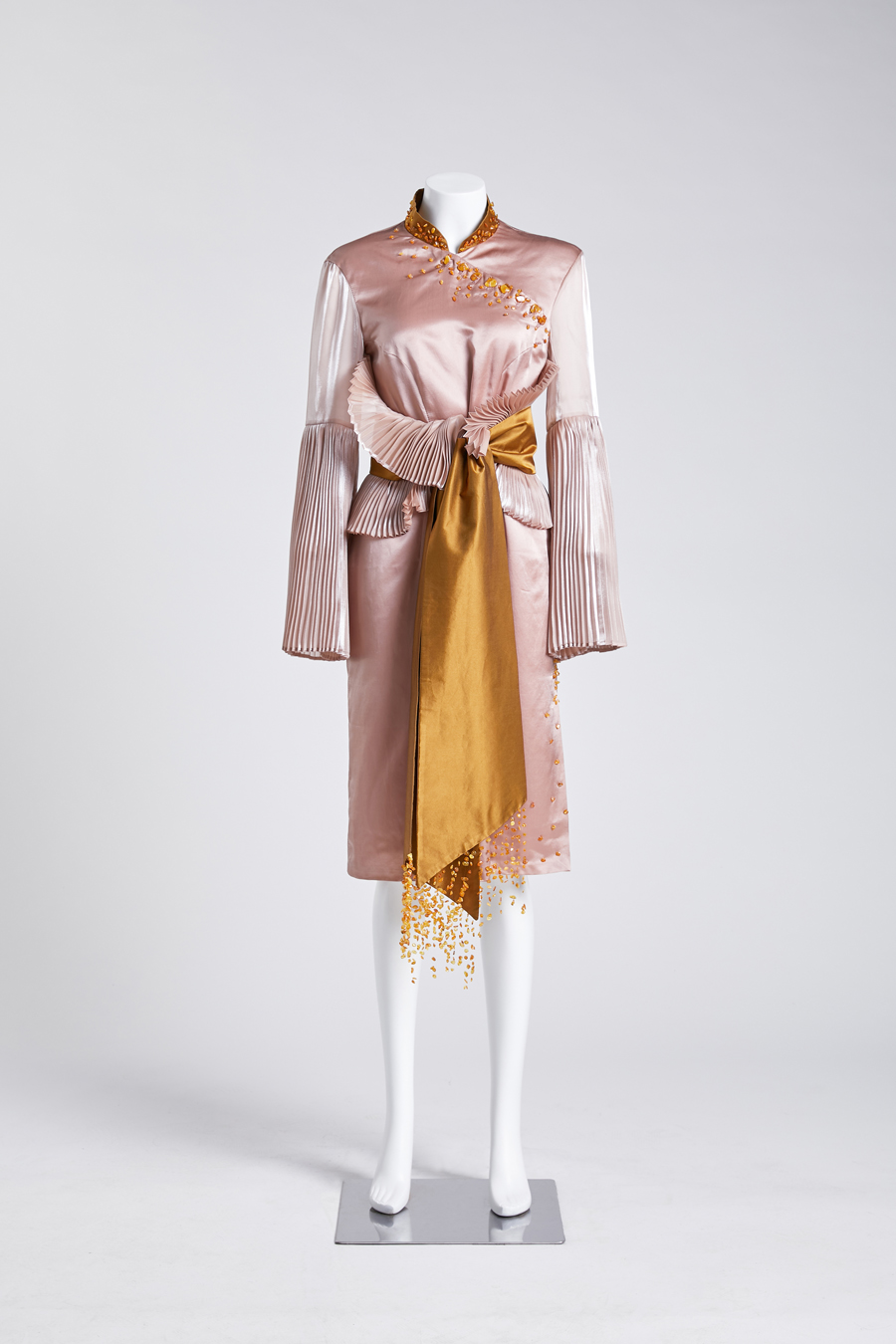
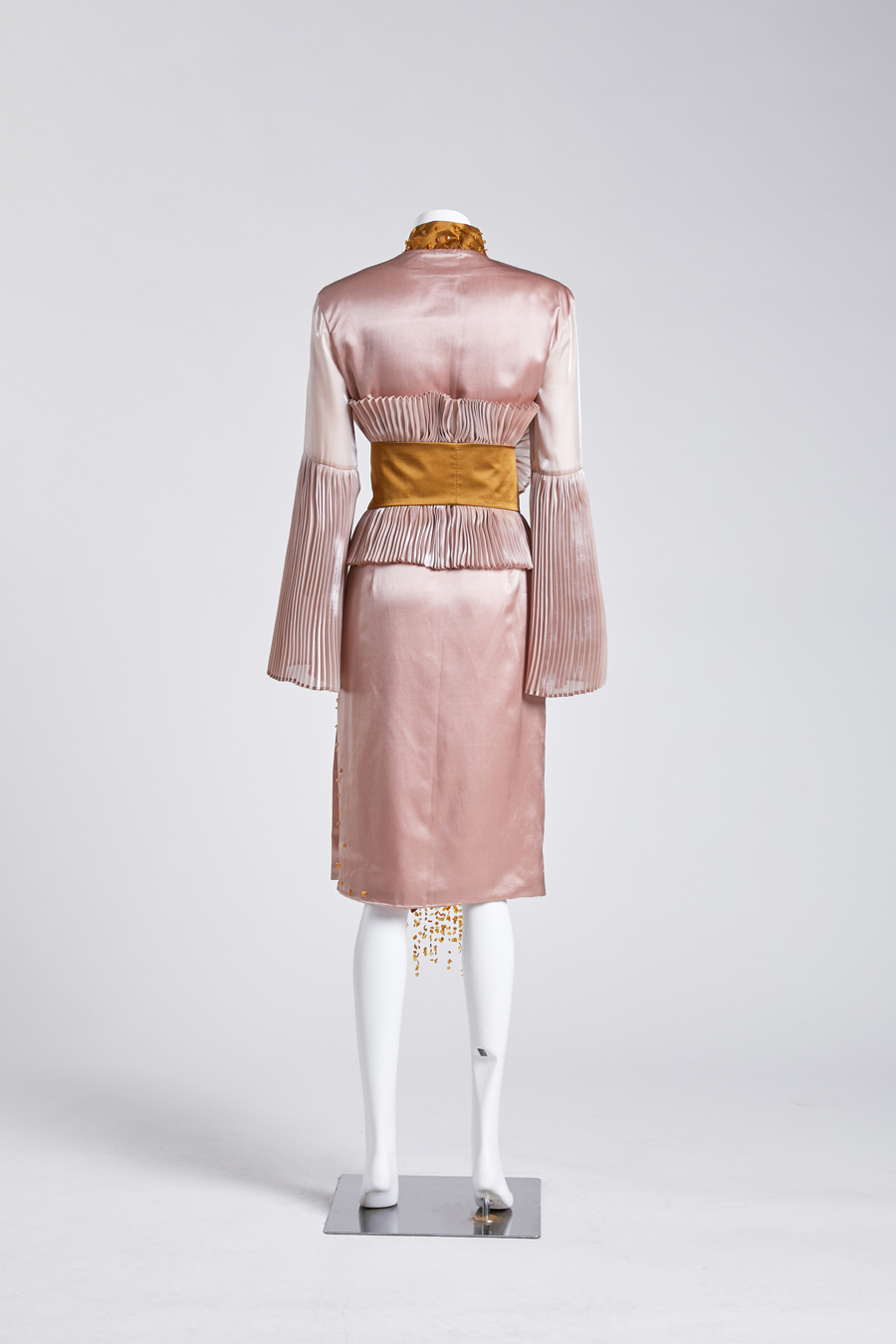
 Pay attention to us
×
Pay attention to us
×